Research: Ethics of Privacy and Anonymity in Online Data Handling
VerifiedAdded on 2021/06/14
|27
|5582
|21
Report
AI Summary
This research report investigates the ethical considerations of privacy and anonymity in the handling of online data by IT professionals. The study explores the challenges and methods employed to maintain user data security in the digital age. Through a literature review, the report defines privacy and anonymity, differentiating between the two concepts and highlighting their importance in various online contexts, such as business, government, and academic settings. The methodology involves surveys, questionnaires, and interviews with IT professionals and their managers to gather data on current practices and issues faced. The findings cover techniques used to maintain privacy, such as encryption and cloud service protocols, and methods for ensuring anonymity, including the use of anonymity servers. The report concludes with an ethical review, consent forms, and pilot study details, offering comprehensive insights into the complexities of online data ethics. The study aims to provide recommendations for improving data handling practices and ensuring user privacy in an increasingly interconnected world.
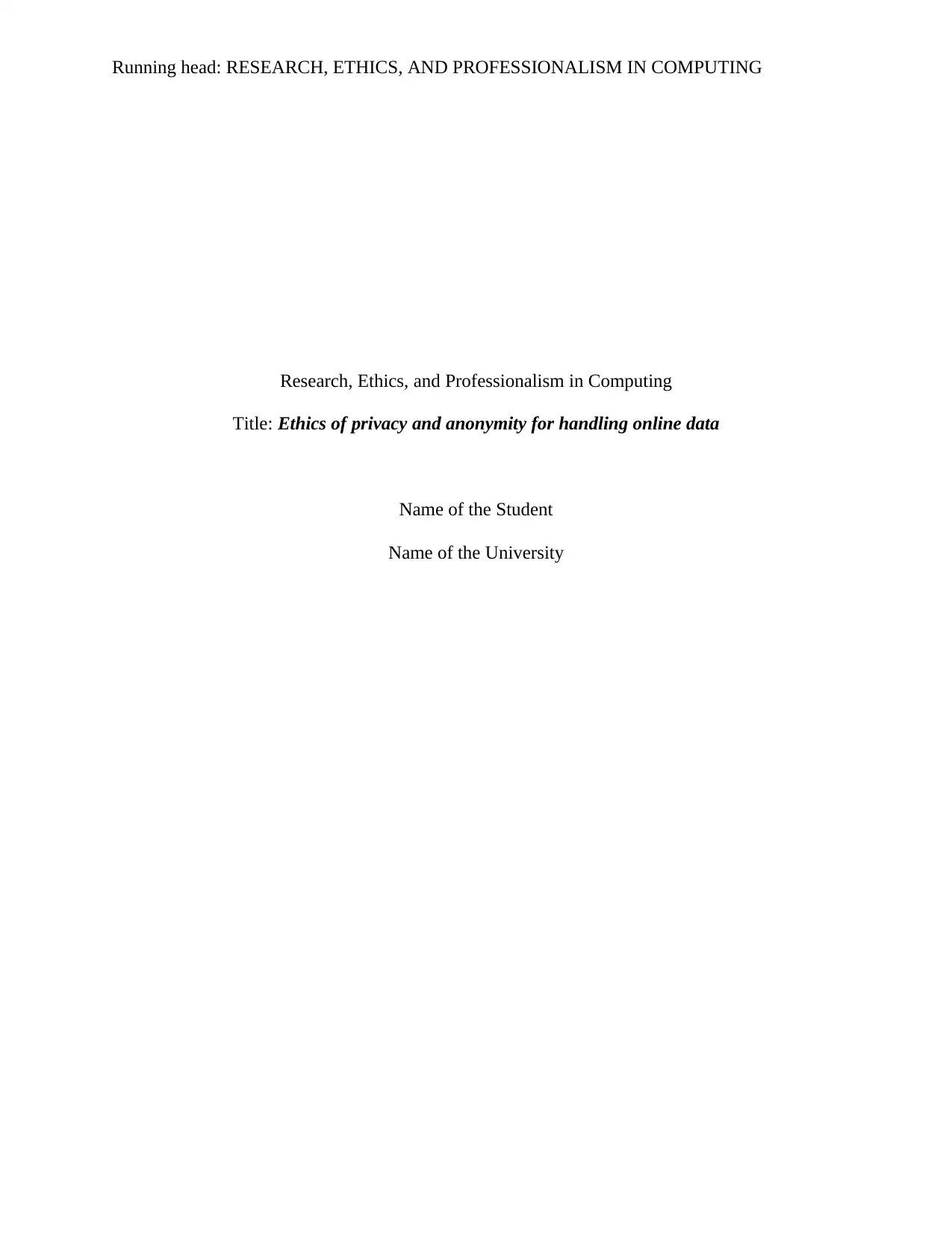
Running head: RESEARCH, ETHICS, AND PROFESSIONALISM IN COMPUTING
Research, Ethics, and Professionalism in Computing
Title: Ethics of privacy and anonymity for handling online data
Name of the Student
Name of the University
Research, Ethics, and Professionalism in Computing
Title: Ethics of privacy and anonymity for handling online data
Name of the Student
Name of the University
Secure Best Marks with AI Grader
Need help grading? Try our AI Grader for instant feedback on your assignments.
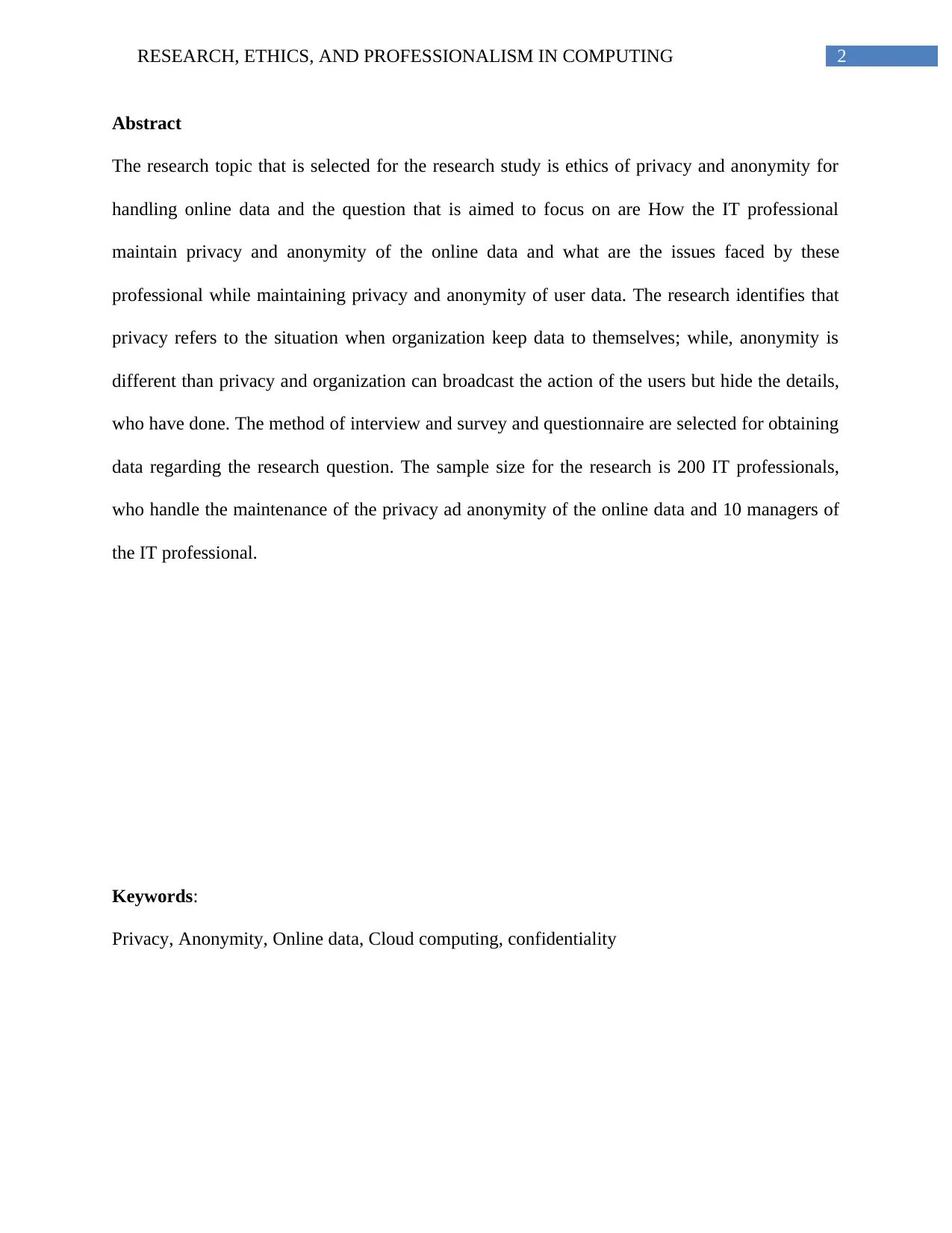
2RESEARCH, ETHICS, AND PROFESSIONALISM IN COMPUTING
Abstract
The research topic that is selected for the research study is ethics of privacy and anonymity for
handling online data and the question that is aimed to focus on are How the IT professional
maintain privacy and anonymity of the online data and what are the issues faced by these
professional while maintaining privacy and anonymity of user data. The research identifies that
privacy refers to the situation when organization keep data to themselves; while, anonymity is
different than privacy and organization can broadcast the action of the users but hide the details,
who have done. The method of interview and survey and questionnaire are selected for obtaining
data regarding the research question. The sample size for the research is 200 IT professionals,
who handle the maintenance of the privacy ad anonymity of the online data and 10 managers of
the IT professional.
Keywords:
Privacy, Anonymity, Online data, Cloud computing, confidentiality
Abstract
The research topic that is selected for the research study is ethics of privacy and anonymity for
handling online data and the question that is aimed to focus on are How the IT professional
maintain privacy and anonymity of the online data and what are the issues faced by these
professional while maintaining privacy and anonymity of user data. The research identifies that
privacy refers to the situation when organization keep data to themselves; while, anonymity is
different than privacy and organization can broadcast the action of the users but hide the details,
who have done. The method of interview and survey and questionnaire are selected for obtaining
data regarding the research question. The sample size for the research is 200 IT professionals,
who handle the maintenance of the privacy ad anonymity of the online data and 10 managers of
the IT professional.
Keywords:
Privacy, Anonymity, Online data, Cloud computing, confidentiality
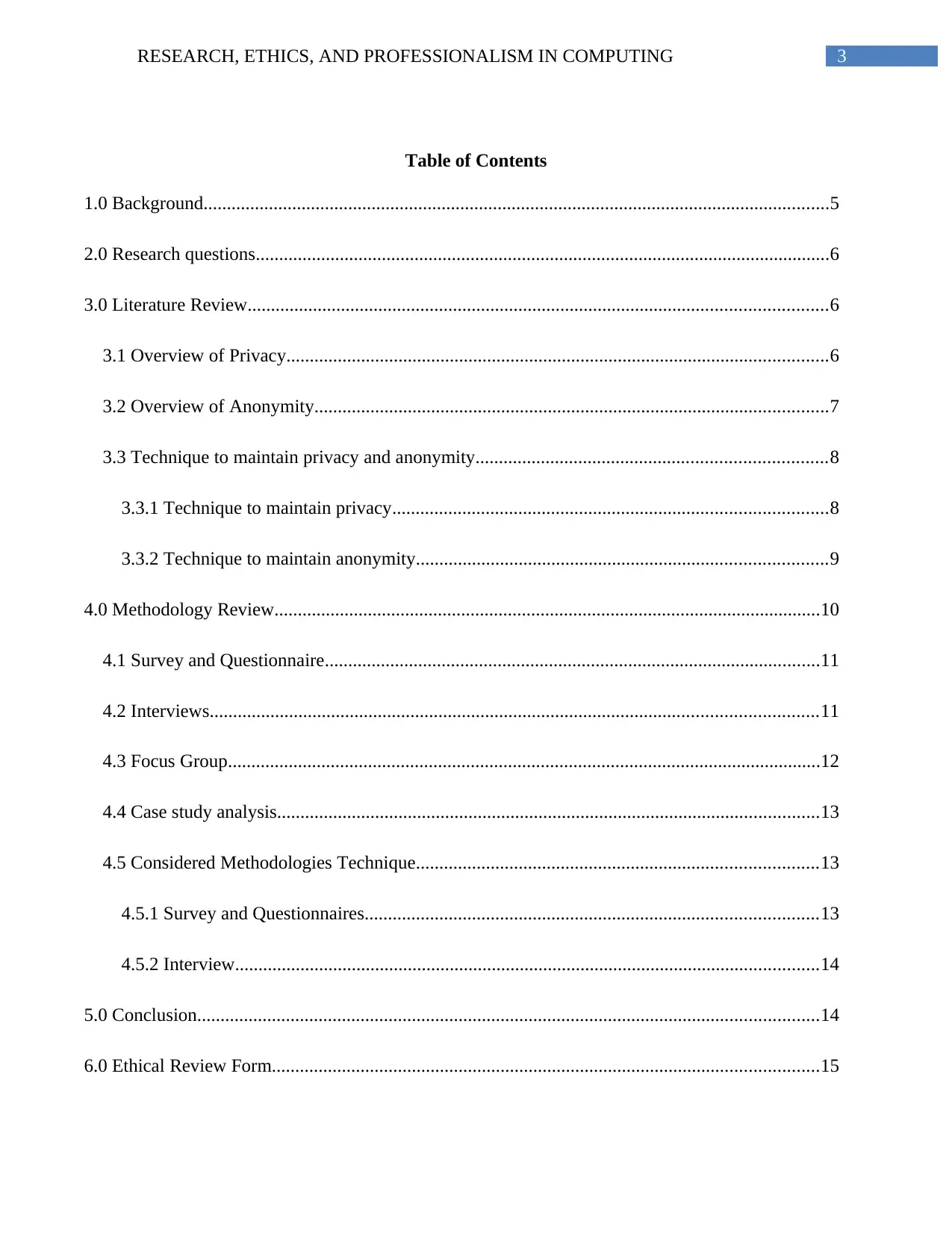
3RESEARCH, ETHICS, AND PROFESSIONALISM IN COMPUTING
Table of Contents
1.0 Background......................................................................................................................................5
2.0 Research questions...........................................................................................................................6
3.0 Literature Review............................................................................................................................6
3.1 Overview of Privacy....................................................................................................................6
3.2 Overview of Anonymity..............................................................................................................7
3.3 Technique to maintain privacy and anonymity...........................................................................8
3.3.1 Technique to maintain privacy.............................................................................................8
3.3.2 Technique to maintain anonymity........................................................................................9
4.0 Methodology Review.....................................................................................................................10
4.1 Survey and Questionnaire..........................................................................................................11
4.2 Interviews..................................................................................................................................11
4.3 Focus Group...............................................................................................................................12
4.4 Case study analysis....................................................................................................................13
4.5 Considered Methodologies Technique......................................................................................13
4.5.1 Survey and Questionnaires.................................................................................................13
4.5.2 Interview.............................................................................................................................14
5.0 Conclusion.....................................................................................................................................14
6.0 Ethical Review Form.....................................................................................................................15
Table of Contents
1.0 Background......................................................................................................................................5
2.0 Research questions...........................................................................................................................6
3.0 Literature Review............................................................................................................................6
3.1 Overview of Privacy....................................................................................................................6
3.2 Overview of Anonymity..............................................................................................................7
3.3 Technique to maintain privacy and anonymity...........................................................................8
3.3.1 Technique to maintain privacy.............................................................................................8
3.3.2 Technique to maintain anonymity........................................................................................9
4.0 Methodology Review.....................................................................................................................10
4.1 Survey and Questionnaire..........................................................................................................11
4.2 Interviews..................................................................................................................................11
4.3 Focus Group...............................................................................................................................12
4.4 Case study analysis....................................................................................................................13
4.5 Considered Methodologies Technique......................................................................................13
4.5.1 Survey and Questionnaires.................................................................................................13
4.5.2 Interview.............................................................................................................................14
5.0 Conclusion.....................................................................................................................................14
6.0 Ethical Review Form.....................................................................................................................15
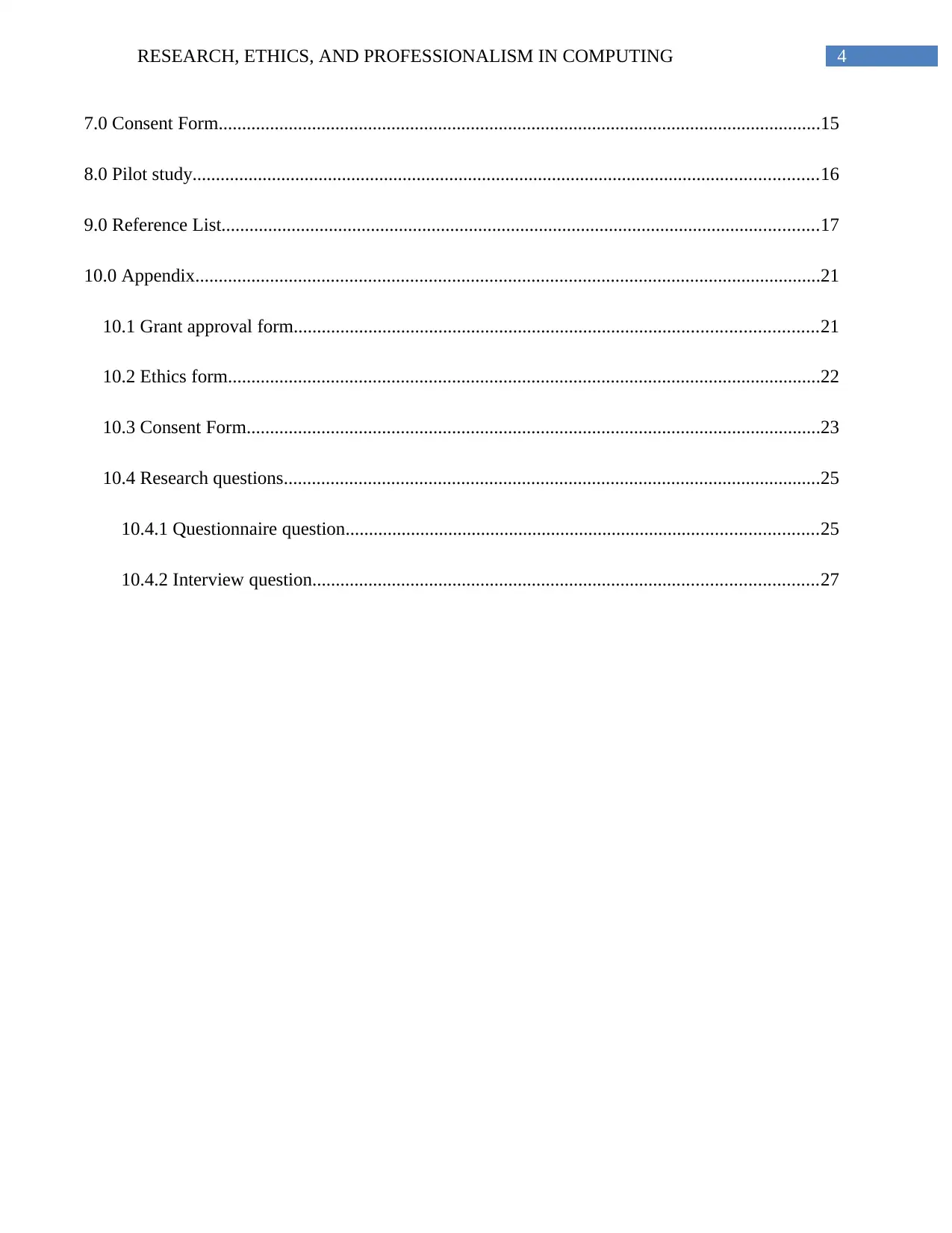
4RESEARCH, ETHICS, AND PROFESSIONALISM IN COMPUTING
7.0 Consent Form.................................................................................................................................15
8.0 Pilot study......................................................................................................................................16
9.0 Reference List................................................................................................................................17
10.0 Appendix......................................................................................................................................21
10.1 Grant approval form................................................................................................................21
10.2 Ethics form...............................................................................................................................22
10.3 Consent Form...........................................................................................................................23
10.4 Research questions...................................................................................................................25
10.4.1 Questionnaire question.....................................................................................................25
10.4.2 Interview question............................................................................................................27
7.0 Consent Form.................................................................................................................................15
8.0 Pilot study......................................................................................................................................16
9.0 Reference List................................................................................................................................17
10.0 Appendix......................................................................................................................................21
10.1 Grant approval form................................................................................................................21
10.2 Ethics form...............................................................................................................................22
10.3 Consent Form...........................................................................................................................23
10.4 Research questions...................................................................................................................25
10.4.1 Questionnaire question.....................................................................................................25
10.4.2 Interview question............................................................................................................27
Secure Best Marks with AI Grader
Need help grading? Try our AI Grader for instant feedback on your assignments.
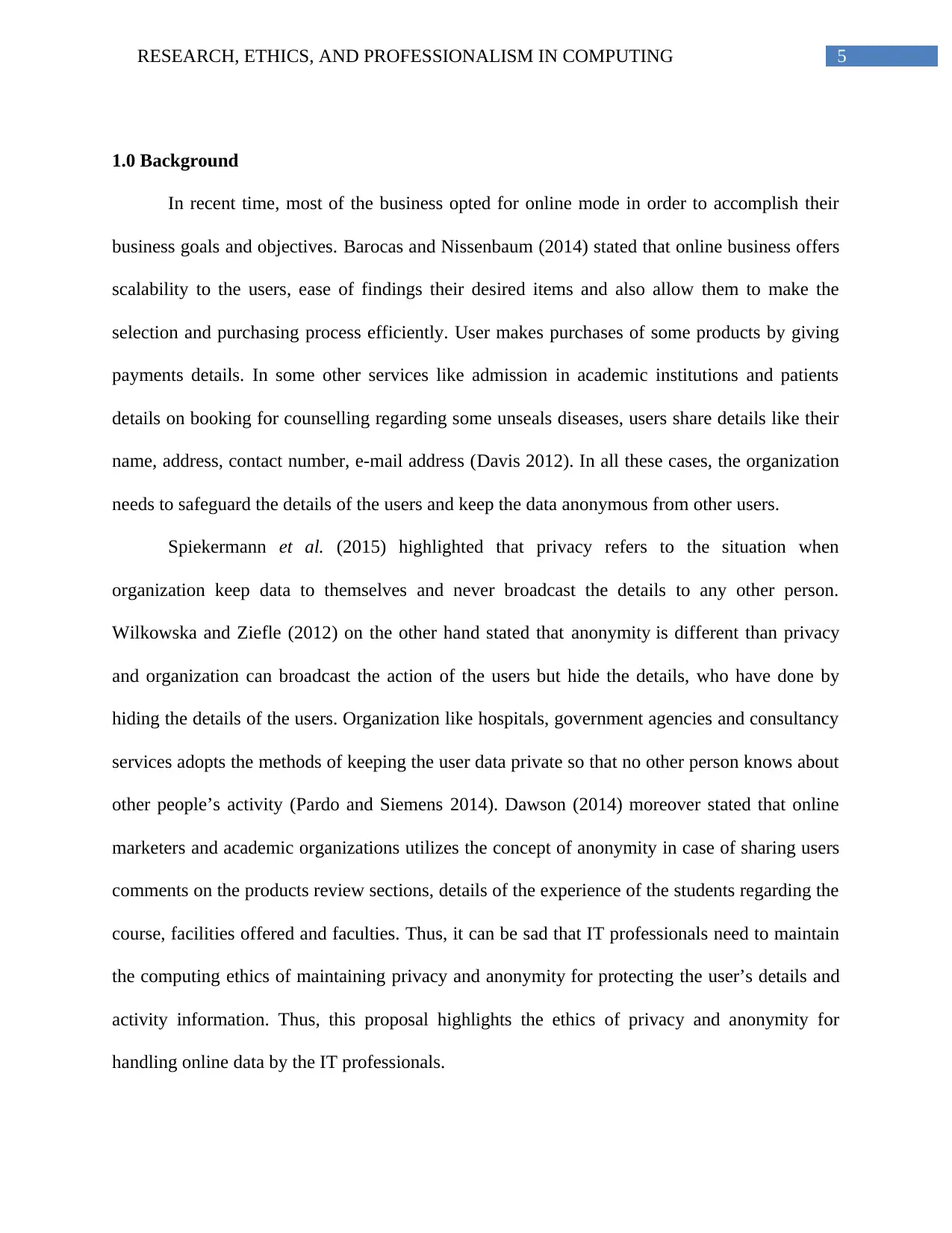
5RESEARCH, ETHICS, AND PROFESSIONALISM IN COMPUTING
1.0 Background
In recent time, most of the business opted for online mode in order to accomplish their
business goals and objectives. Barocas and Nissenbaum (2014) stated that online business offers
scalability to the users, ease of findings their desired items and also allow them to make the
selection and purchasing process efficiently. User makes purchases of some products by giving
payments details. In some other services like admission in academic institutions and patients
details on booking for counselling regarding some unseals diseases, users share details like their
name, address, contact number, e-mail address (Davis 2012). In all these cases, the organization
needs to safeguard the details of the users and keep the data anonymous from other users.
Spiekermann et al. (2015) highlighted that privacy refers to the situation when
organization keep data to themselves and never broadcast the details to any other person.
Wilkowska and Ziefle (2012) on the other hand stated that anonymity is different than privacy
and organization can broadcast the action of the users but hide the details, who have done by
hiding the details of the users. Organization like hospitals, government agencies and consultancy
services adopts the methods of keeping the user data private so that no other person knows about
other people’s activity (Pardo and Siemens 2014). Dawson (2014) moreover stated that online
marketers and academic organizations utilizes the concept of anonymity in case of sharing users
comments on the products review sections, details of the experience of the students regarding the
course, facilities offered and faculties. Thus, it can be sad that IT professionals need to maintain
the computing ethics of maintaining privacy and anonymity for protecting the user’s details and
activity information. Thus, this proposal highlights the ethics of privacy and anonymity for
handling online data by the IT professionals.
1.0 Background
In recent time, most of the business opted for online mode in order to accomplish their
business goals and objectives. Barocas and Nissenbaum (2014) stated that online business offers
scalability to the users, ease of findings their desired items and also allow them to make the
selection and purchasing process efficiently. User makes purchases of some products by giving
payments details. In some other services like admission in academic institutions and patients
details on booking for counselling regarding some unseals diseases, users share details like their
name, address, contact number, e-mail address (Davis 2012). In all these cases, the organization
needs to safeguard the details of the users and keep the data anonymous from other users.
Spiekermann et al. (2015) highlighted that privacy refers to the situation when
organization keep data to themselves and never broadcast the details to any other person.
Wilkowska and Ziefle (2012) on the other hand stated that anonymity is different than privacy
and organization can broadcast the action of the users but hide the details, who have done by
hiding the details of the users. Organization like hospitals, government agencies and consultancy
services adopts the methods of keeping the user data private so that no other person knows about
other people’s activity (Pardo and Siemens 2014). Dawson (2014) moreover stated that online
marketers and academic organizations utilizes the concept of anonymity in case of sharing users
comments on the products review sections, details of the experience of the students regarding the
course, facilities offered and faculties. Thus, it can be sad that IT professionals need to maintain
the computing ethics of maintaining privacy and anonymity for protecting the user’s details and
activity information. Thus, this proposal highlights the ethics of privacy and anonymity for
handling online data by the IT professionals.
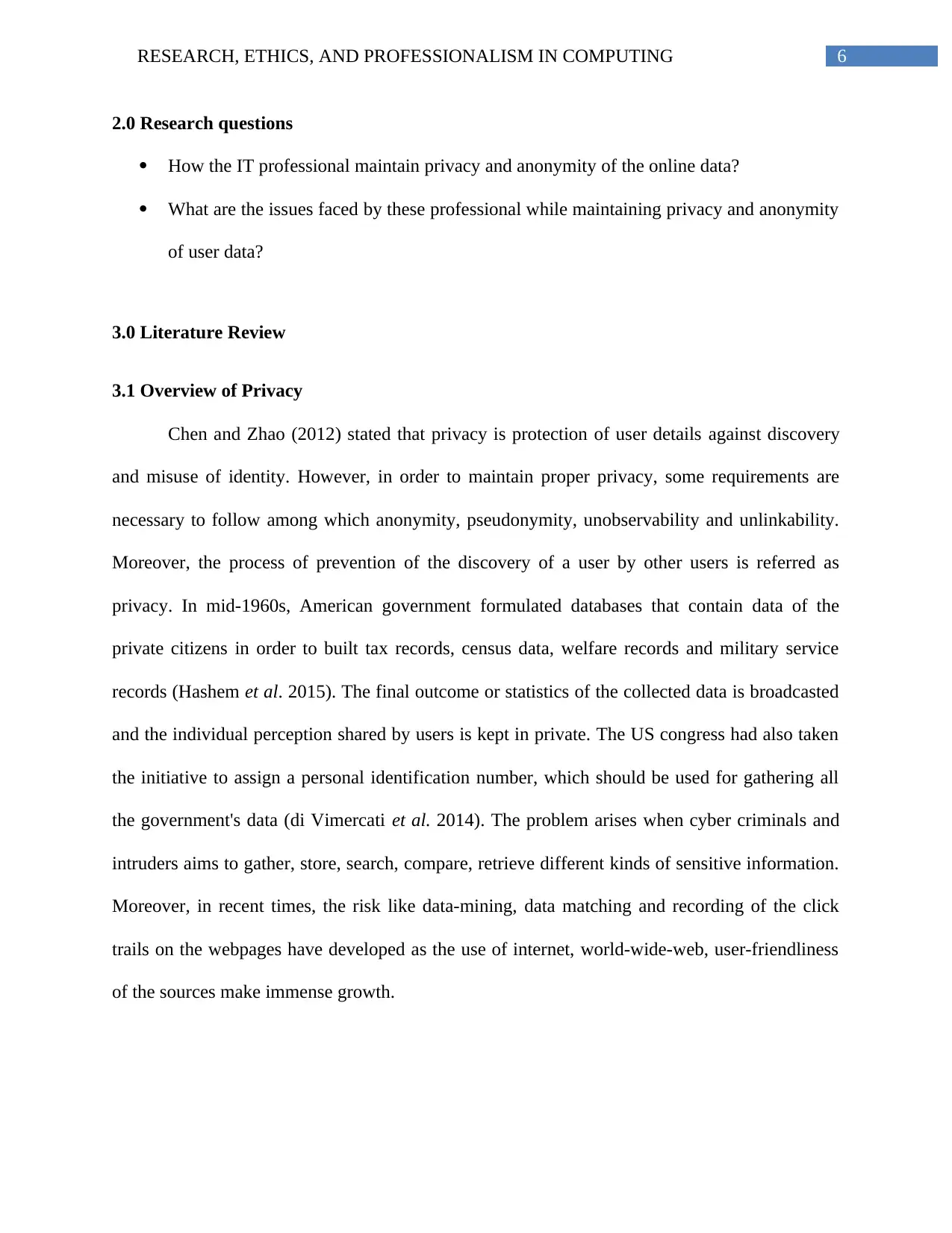
6RESEARCH, ETHICS, AND PROFESSIONALISM IN COMPUTING
2.0 Research questions
How the IT professional maintain privacy and anonymity of the online data?
What are the issues faced by these professional while maintaining privacy and anonymity
of user data?
3.0 Literature Review
3.1 Overview of Privacy
Chen and Zhao (2012) stated that privacy is protection of user details against discovery
and misuse of identity. However, in order to maintain proper privacy, some requirements are
necessary to follow among which anonymity, pseudonymity, unobservability and unlinkability.
Moreover, the process of prevention of the discovery of a user by other users is referred as
privacy. In mid-1960s, American government formulated databases that contain data of the
private citizens in order to built tax records, census data, welfare records and military service
records (Hashem et al. 2015). The final outcome or statistics of the collected data is broadcasted
and the individual perception shared by users is kept in private. The US congress had also taken
the initiative to assign a personal identification number, which should be used for gathering all
the government's data (di Vimercati et al. 2014). The problem arises when cyber criminals and
intruders aims to gather, store, search, compare, retrieve different kinds of sensitive information.
Moreover, in recent times, the risk like data-mining, data matching and recording of the click
trails on the webpages have developed as the use of internet, world-wide-web, user-friendliness
of the sources make immense growth.
2.0 Research questions
How the IT professional maintain privacy and anonymity of the online data?
What are the issues faced by these professional while maintaining privacy and anonymity
of user data?
3.0 Literature Review
3.1 Overview of Privacy
Chen and Zhao (2012) stated that privacy is protection of user details against discovery
and misuse of identity. However, in order to maintain proper privacy, some requirements are
necessary to follow among which anonymity, pseudonymity, unobservability and unlinkability.
Moreover, the process of prevention of the discovery of a user by other users is referred as
privacy. In mid-1960s, American government formulated databases that contain data of the
private citizens in order to built tax records, census data, welfare records and military service
records (Hashem et al. 2015). The final outcome or statistics of the collected data is broadcasted
and the individual perception shared by users is kept in private. The US congress had also taken
the initiative to assign a personal identification number, which should be used for gathering all
the government's data (di Vimercati et al. 2014). The problem arises when cyber criminals and
intruders aims to gather, store, search, compare, retrieve different kinds of sensitive information.
Moreover, in recent times, the risk like data-mining, data matching and recording of the click
trails on the webpages have developed as the use of internet, world-wide-web, user-friendliness
of the sources make immense growth.
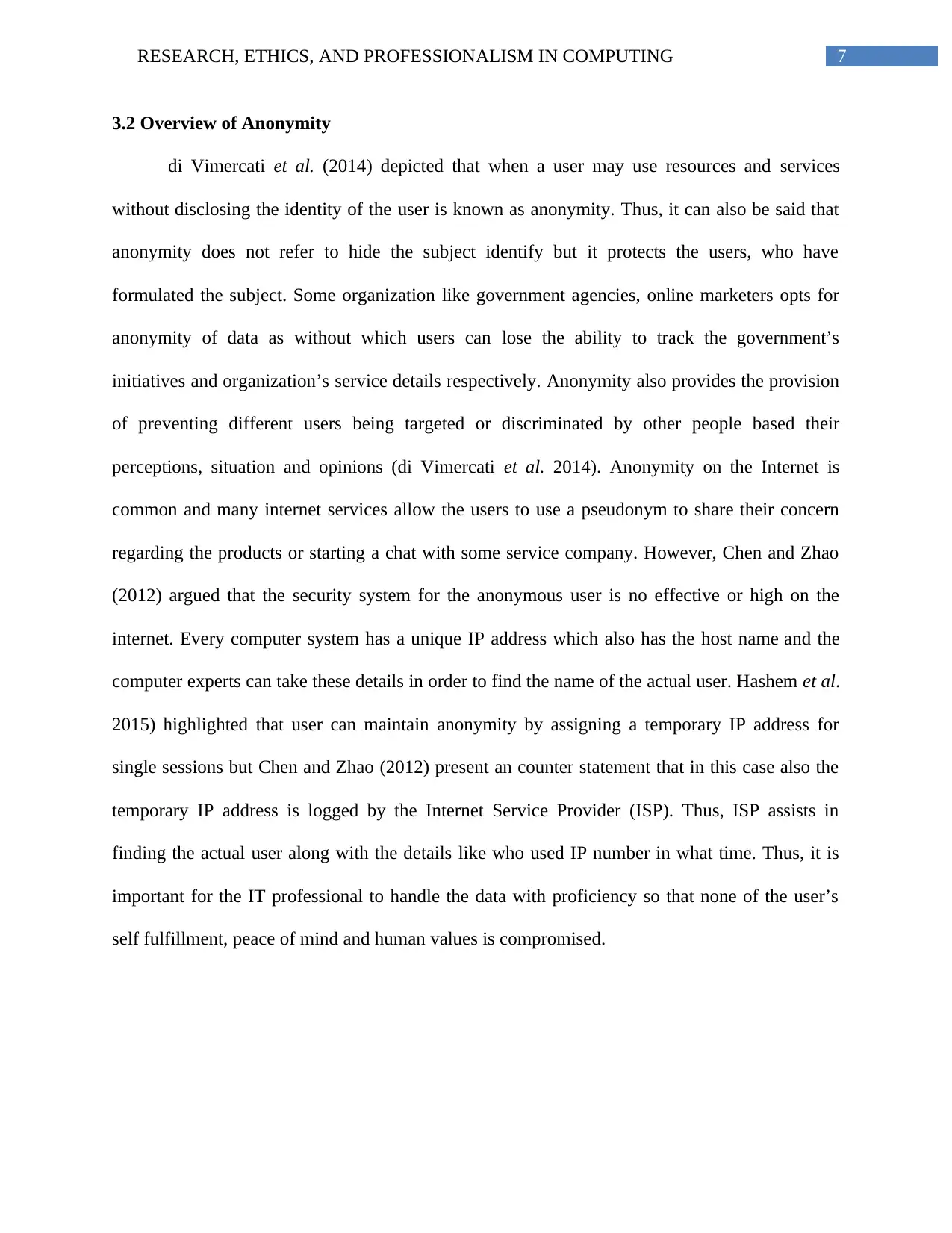
7RESEARCH, ETHICS, AND PROFESSIONALISM IN COMPUTING
3.2 Overview of Anonymity
di Vimercati et al. (2014) depicted that when a user may use resources and services
without disclosing the identity of the user is known as anonymity. Thus, it can also be said that
anonymity does not refer to hide the subject identify but it protects the users, who have
formulated the subject. Some organization like government agencies, online marketers opts for
anonymity of data as without which users can lose the ability to track the government’s
initiatives and organization’s service details respectively. Anonymity also provides the provision
of preventing different users being targeted or discriminated by other people based their
perceptions, situation and opinions (di Vimercati et al. 2014). Anonymity on the Internet is
common and many internet services allow the users to use a pseudonym to share their concern
regarding the products or starting a chat with some service company. However, Chen and Zhao
(2012) argued that the security system for the anonymous user is no effective or high on the
internet. Every computer system has a unique IP address which also has the host name and the
computer experts can take these details in order to find the name of the actual user. Hashem et al.
2015) highlighted that user can maintain anonymity by assigning a temporary IP address for
single sessions but Chen and Zhao (2012) present an counter statement that in this case also the
temporary IP address is logged by the Internet Service Provider (ISP). Thus, ISP assists in
finding the actual user along with the details like who used IP number in what time. Thus, it is
important for the IT professional to handle the data with proficiency so that none of the user’s
self fulfillment, peace of mind and human values is compromised.
3.2 Overview of Anonymity
di Vimercati et al. (2014) depicted that when a user may use resources and services
without disclosing the identity of the user is known as anonymity. Thus, it can also be said that
anonymity does not refer to hide the subject identify but it protects the users, who have
formulated the subject. Some organization like government agencies, online marketers opts for
anonymity of data as without which users can lose the ability to track the government’s
initiatives and organization’s service details respectively. Anonymity also provides the provision
of preventing different users being targeted or discriminated by other people based their
perceptions, situation and opinions (di Vimercati et al. 2014). Anonymity on the Internet is
common and many internet services allow the users to use a pseudonym to share their concern
regarding the products or starting a chat with some service company. However, Chen and Zhao
(2012) argued that the security system for the anonymous user is no effective or high on the
internet. Every computer system has a unique IP address which also has the host name and the
computer experts can take these details in order to find the name of the actual user. Hashem et al.
2015) highlighted that user can maintain anonymity by assigning a temporary IP address for
single sessions but Chen and Zhao (2012) present an counter statement that in this case also the
temporary IP address is logged by the Internet Service Provider (ISP). Thus, ISP assists in
finding the actual user along with the details like who used IP number in what time. Thus, it is
important for the IT professional to handle the data with proficiency so that none of the user’s
self fulfillment, peace of mind and human values is compromised.
Paraphrase This Document
Need a fresh take? Get an instant paraphrase of this document with our AI Paraphraser
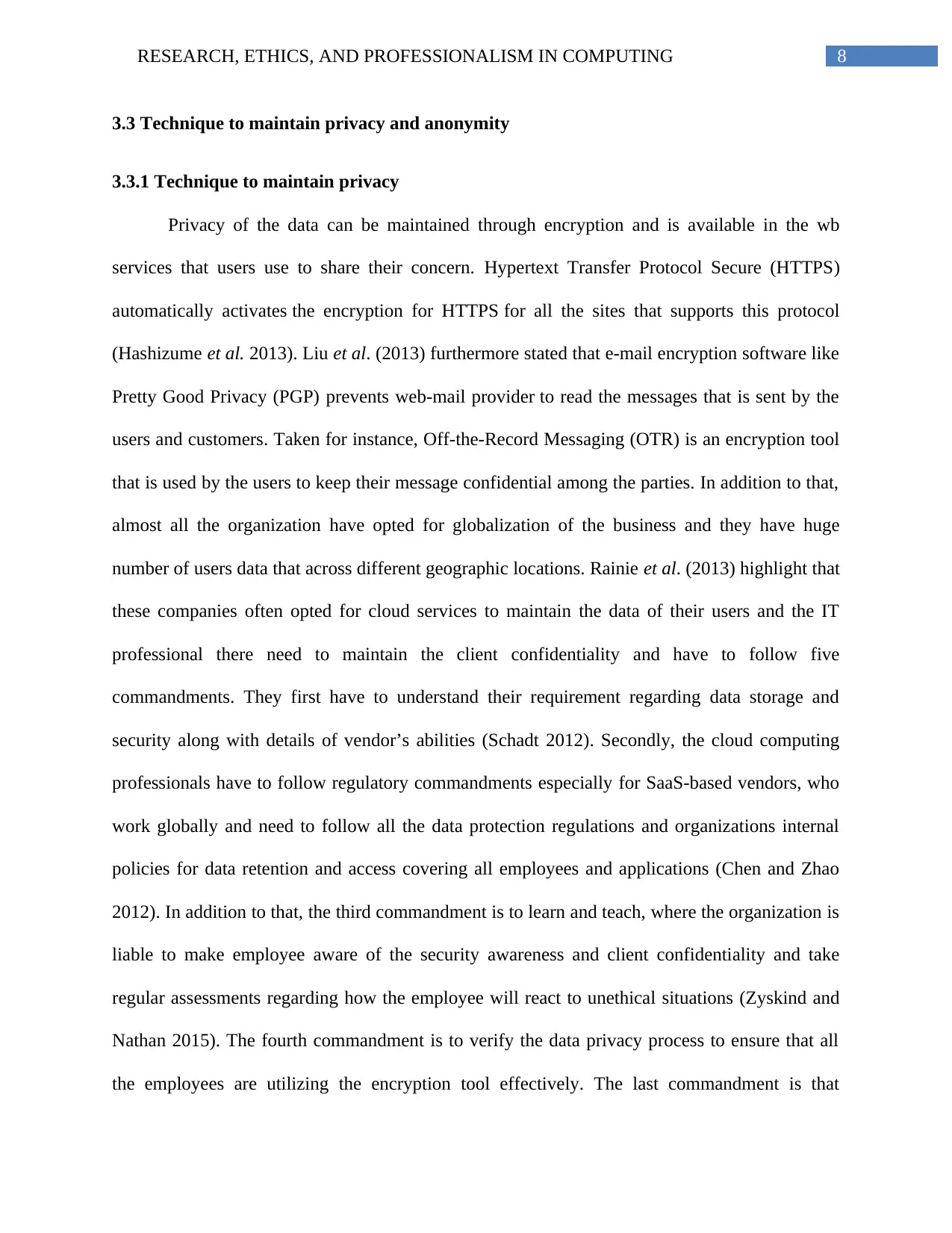
8RESEARCH, ETHICS, AND PROFESSIONALISM IN COMPUTING
3.3 Technique to maintain privacy and anonymity
3.3.1 Technique to maintain privacy
Privacy of the data can be maintained through encryption and is available in the wb
services that users use to share their concern. Hypertext Transfer Protocol Secure (HTTPS)
automatically activates the encryption for HTTPS for all the sites that supports this protocol
(Hashizume et al. 2013). Liu et al. (2013) furthermore stated that e-mail encryption software like
Pretty Good Privacy (PGP) prevents web-mail provider to read the messages that is sent by the
users and customers. Taken for instance, Off-the-Record Messaging (OTR) is an encryption tool
that is used by the users to keep their message confidential among the parties. In addition to that,
almost all the organization have opted for globalization of the business and they have huge
number of users data that across different geographic locations. Rainie et al. (2013) highlight that
these companies often opted for cloud services to maintain the data of their users and the IT
professional there need to maintain the client confidentiality and have to follow five
commandments. They first have to understand their requirement regarding data storage and
security along with details of vendor’s abilities (Schadt 2012). Secondly, the cloud computing
professionals have to follow regulatory commandments especially for SaaS-based vendors, who
work globally and need to follow all the data protection regulations and organizations internal
policies for data retention and access covering all employees and applications (Chen and Zhao
2012). In addition to that, the third commandment is to learn and teach, where the organization is
liable to make employee aware of the security awareness and client confidentiality and take
regular assessments regarding how the employee will react to unethical situations (Zyskind and
Nathan 2015). The fourth commandment is to verify the data privacy process to ensure that all
the employees are utilizing the encryption tool effectively. The last commandment is that
3.3 Technique to maintain privacy and anonymity
3.3.1 Technique to maintain privacy
Privacy of the data can be maintained through encryption and is available in the wb
services that users use to share their concern. Hypertext Transfer Protocol Secure (HTTPS)
automatically activates the encryption for HTTPS for all the sites that supports this protocol
(Hashizume et al. 2013). Liu et al. (2013) furthermore stated that e-mail encryption software like
Pretty Good Privacy (PGP) prevents web-mail provider to read the messages that is sent by the
users and customers. Taken for instance, Off-the-Record Messaging (OTR) is an encryption tool
that is used by the users to keep their message confidential among the parties. In addition to that,
almost all the organization have opted for globalization of the business and they have huge
number of users data that across different geographic locations. Rainie et al. (2013) highlight that
these companies often opted for cloud services to maintain the data of their users and the IT
professional there need to maintain the client confidentiality and have to follow five
commandments. They first have to understand their requirement regarding data storage and
security along with details of vendor’s abilities (Schadt 2012). Secondly, the cloud computing
professionals have to follow regulatory commandments especially for SaaS-based vendors, who
work globally and need to follow all the data protection regulations and organizations internal
policies for data retention and access covering all employees and applications (Chen and Zhao
2012). In addition to that, the third commandment is to learn and teach, where the organization is
liable to make employee aware of the security awareness and client confidentiality and take
regular assessments regarding how the employee will react to unethical situations (Zyskind and
Nathan 2015). The fourth commandment is to verify the data privacy process to ensure that all
the employees are utilizing the encryption tool effectively. The last commandment is that
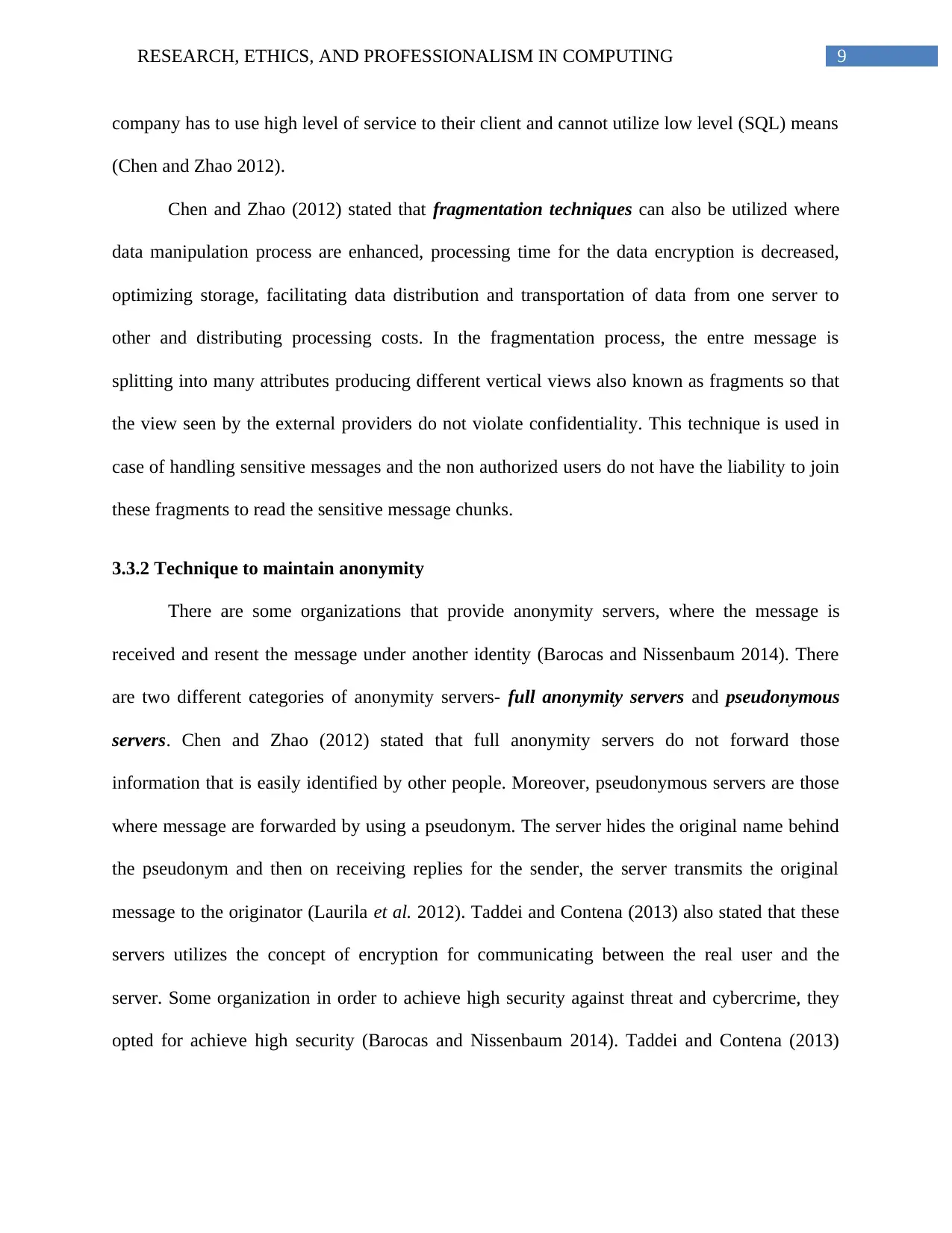
9RESEARCH, ETHICS, AND PROFESSIONALISM IN COMPUTING
company has to use high level of service to their client and cannot utilize low level (SQL) means
(Chen and Zhao 2012).
Chen and Zhao (2012) stated that fragmentation techniques can also be utilized where
data manipulation process are enhanced, processing time for the data encryption is decreased,
optimizing storage, facilitating data distribution and transportation of data from one server to
other and distributing processing costs. In the fragmentation process, the entre message is
splitting into many attributes producing different vertical views also known as fragments so that
the view seen by the external providers do not violate confidentiality. This technique is used in
case of handling sensitive messages and the non authorized users do not have the liability to join
these fragments to read the sensitive message chunks.
3.3.2 Technique to maintain anonymity
There are some organizations that provide anonymity servers, where the message is
received and resent the message under another identity (Barocas and Nissenbaum 2014). There
are two different categories of anonymity servers- full anonymity servers and pseudonymous
servers. Chen and Zhao (2012) stated that full anonymity servers do not forward those
information that is easily identified by other people. Moreover, pseudonymous servers are those
where message are forwarded by using a pseudonym. The server hides the original name behind
the pseudonym and then on receiving replies for the sender, the server transmits the original
message to the originator (Laurila et al. 2012). Taddei and Contena (2013) also stated that these
servers utilizes the concept of encryption for communicating between the real user and the
server. Some organization in order to achieve high security against threat and cybercrime, they
opted for achieve high security (Barocas and Nissenbaum 2014). Taddei and Contena (2013)
company has to use high level of service to their client and cannot utilize low level (SQL) means
(Chen and Zhao 2012).
Chen and Zhao (2012) stated that fragmentation techniques can also be utilized where
data manipulation process are enhanced, processing time for the data encryption is decreased,
optimizing storage, facilitating data distribution and transportation of data from one server to
other and distributing processing costs. In the fragmentation process, the entre message is
splitting into many attributes producing different vertical views also known as fragments so that
the view seen by the external providers do not violate confidentiality. This technique is used in
case of handling sensitive messages and the non authorized users do not have the liability to join
these fragments to read the sensitive message chunks.
3.3.2 Technique to maintain anonymity
There are some organizations that provide anonymity servers, where the message is
received and resent the message under another identity (Barocas and Nissenbaum 2014). There
are two different categories of anonymity servers- full anonymity servers and pseudonymous
servers. Chen and Zhao (2012) stated that full anonymity servers do not forward those
information that is easily identified by other people. Moreover, pseudonymous servers are those
where message are forwarded by using a pseudonym. The server hides the original name behind
the pseudonym and then on receiving replies for the sender, the server transmits the original
message to the originator (Laurila et al. 2012). Taddei and Contena (2013) also stated that these
servers utilizes the concept of encryption for communicating between the real user and the
server. Some organization in order to achieve high security against threat and cybercrime, they
opted for achieve high security (Barocas and Nissenbaum 2014). Taddei and Contena (2013)
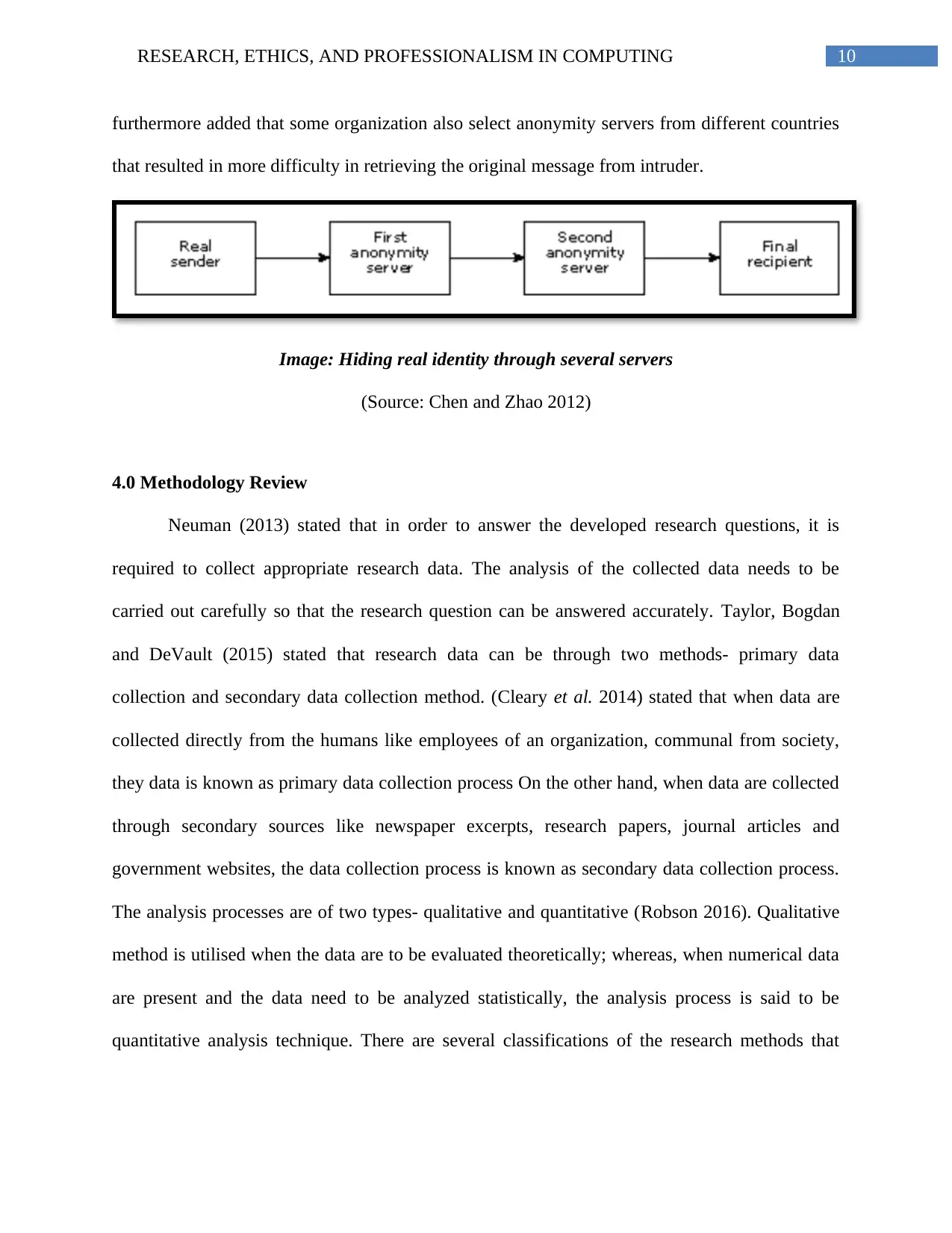
10RESEARCH, ETHICS, AND PROFESSIONALISM IN COMPUTING
furthermore added that some organization also select anonymity servers from different countries
that resulted in more difficulty in retrieving the original message from intruder.
Image: Hiding real identity through several servers
(Source: Chen and Zhao 2012)
4.0 Methodology Review
Neuman (2013) stated that in order to answer the developed research questions, it is
required to collect appropriate research data. The analysis of the collected data needs to be
carried out carefully so that the research question can be answered accurately. Taylor, Bogdan
and DeVault (2015) stated that research data can be through two methods- primary data
collection and secondary data collection method. (Cleary et al. 2014) stated that when data are
collected directly from the humans like employees of an organization, communal from society,
they data is known as primary data collection process On the other hand, when data are collected
through secondary sources like newspaper excerpts, research papers, journal articles and
government websites, the data collection process is known as secondary data collection process.
The analysis processes are of two types- qualitative and quantitative (Robson 2016). Qualitative
method is utilised when the data are to be evaluated theoretically; whereas, when numerical data
are present and the data need to be analyzed statistically, the analysis process is said to be
quantitative analysis technique. There are several classifications of the research methods that
furthermore added that some organization also select anonymity servers from different countries
that resulted in more difficulty in retrieving the original message from intruder.
Image: Hiding real identity through several servers
(Source: Chen and Zhao 2012)
4.0 Methodology Review
Neuman (2013) stated that in order to answer the developed research questions, it is
required to collect appropriate research data. The analysis of the collected data needs to be
carried out carefully so that the research question can be answered accurately. Taylor, Bogdan
and DeVault (2015) stated that research data can be through two methods- primary data
collection and secondary data collection method. (Cleary et al. 2014) stated that when data are
collected directly from the humans like employees of an organization, communal from society,
they data is known as primary data collection process On the other hand, when data are collected
through secondary sources like newspaper excerpts, research papers, journal articles and
government websites, the data collection process is known as secondary data collection process.
The analysis processes are of two types- qualitative and quantitative (Robson 2016). Qualitative
method is utilised when the data are to be evaluated theoretically; whereas, when numerical data
are present and the data need to be analyzed statistically, the analysis process is said to be
quantitative analysis technique. There are several classifications of the research methods that
Secure Best Marks with AI Grader
Need help grading? Try our AI Grader for instant feedback on your assignments.
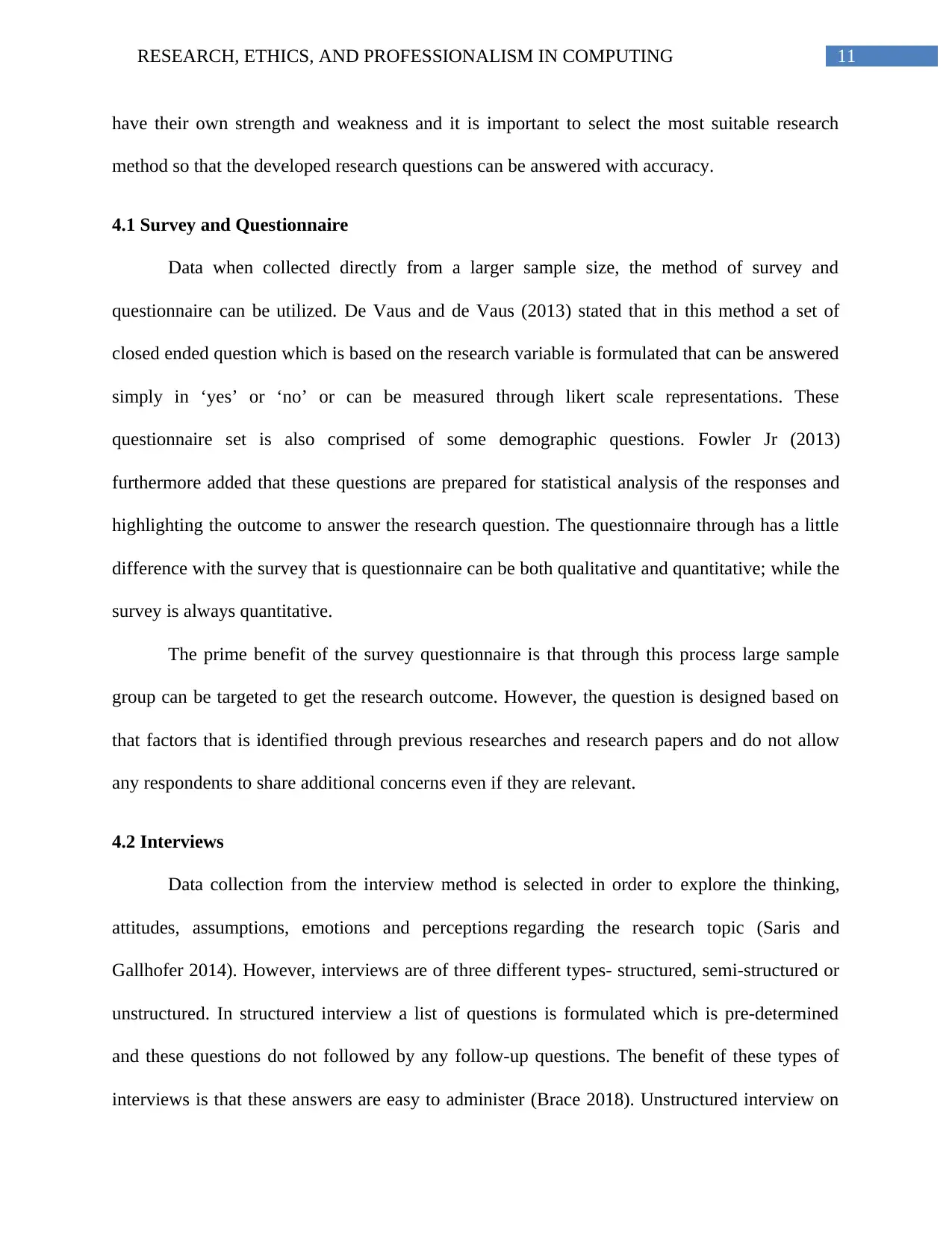
11RESEARCH, ETHICS, AND PROFESSIONALISM IN COMPUTING
have their own strength and weakness and it is important to select the most suitable research
method so that the developed research questions can be answered with accuracy.
4.1 Survey and Questionnaire
Data when collected directly from a larger sample size, the method of survey and
questionnaire can be utilized. De Vaus and de Vaus (2013) stated that in this method a set of
closed ended question which is based on the research variable is formulated that can be answered
simply in ‘yes’ or ‘no’ or can be measured through likert scale representations. These
questionnaire set is also comprised of some demographic questions. Fowler Jr (2013)
furthermore added that these questions are prepared for statistical analysis of the responses and
highlighting the outcome to answer the research question. The questionnaire through has a little
difference with the survey that is questionnaire can be both qualitative and quantitative; while the
survey is always quantitative.
The prime benefit of the survey questionnaire is that through this process large sample
group can be targeted to get the research outcome. However, the question is designed based on
that factors that is identified through previous researches and research papers and do not allow
any respondents to share additional concerns even if they are relevant.
4.2 Interviews
Data collection from the interview method is selected in order to explore the thinking,
attitudes, assumptions, emotions and perceptions regarding the research topic (Saris and
Gallhofer 2014). However, interviews are of three different types- structured, semi-structured or
unstructured. In structured interview a list of questions is formulated which is pre-determined
and these questions do not followed by any follow-up questions. The benefit of these types of
interviews is that these answers are easy to administer (Brace 2018). Unstructured interview on
have their own strength and weakness and it is important to select the most suitable research
method so that the developed research questions can be answered with accuracy.
4.1 Survey and Questionnaire
Data when collected directly from a larger sample size, the method of survey and
questionnaire can be utilized. De Vaus and de Vaus (2013) stated that in this method a set of
closed ended question which is based on the research variable is formulated that can be answered
simply in ‘yes’ or ‘no’ or can be measured through likert scale representations. These
questionnaire set is also comprised of some demographic questions. Fowler Jr (2013)
furthermore added that these questions are prepared for statistical analysis of the responses and
highlighting the outcome to answer the research question. The questionnaire through has a little
difference with the survey that is questionnaire can be both qualitative and quantitative; while the
survey is always quantitative.
The prime benefit of the survey questionnaire is that through this process large sample
group can be targeted to get the research outcome. However, the question is designed based on
that factors that is identified through previous researches and research papers and do not allow
any respondents to share additional concerns even if they are relevant.
4.2 Interviews
Data collection from the interview method is selected in order to explore the thinking,
attitudes, assumptions, emotions and perceptions regarding the research topic (Saris and
Gallhofer 2014). However, interviews are of three different types- structured, semi-structured or
unstructured. In structured interview a list of questions is formulated which is pre-determined
and these questions do not followed by any follow-up questions. The benefit of these types of
interviews is that these answers are easy to administer (Brace 2018). Unstructured interview on
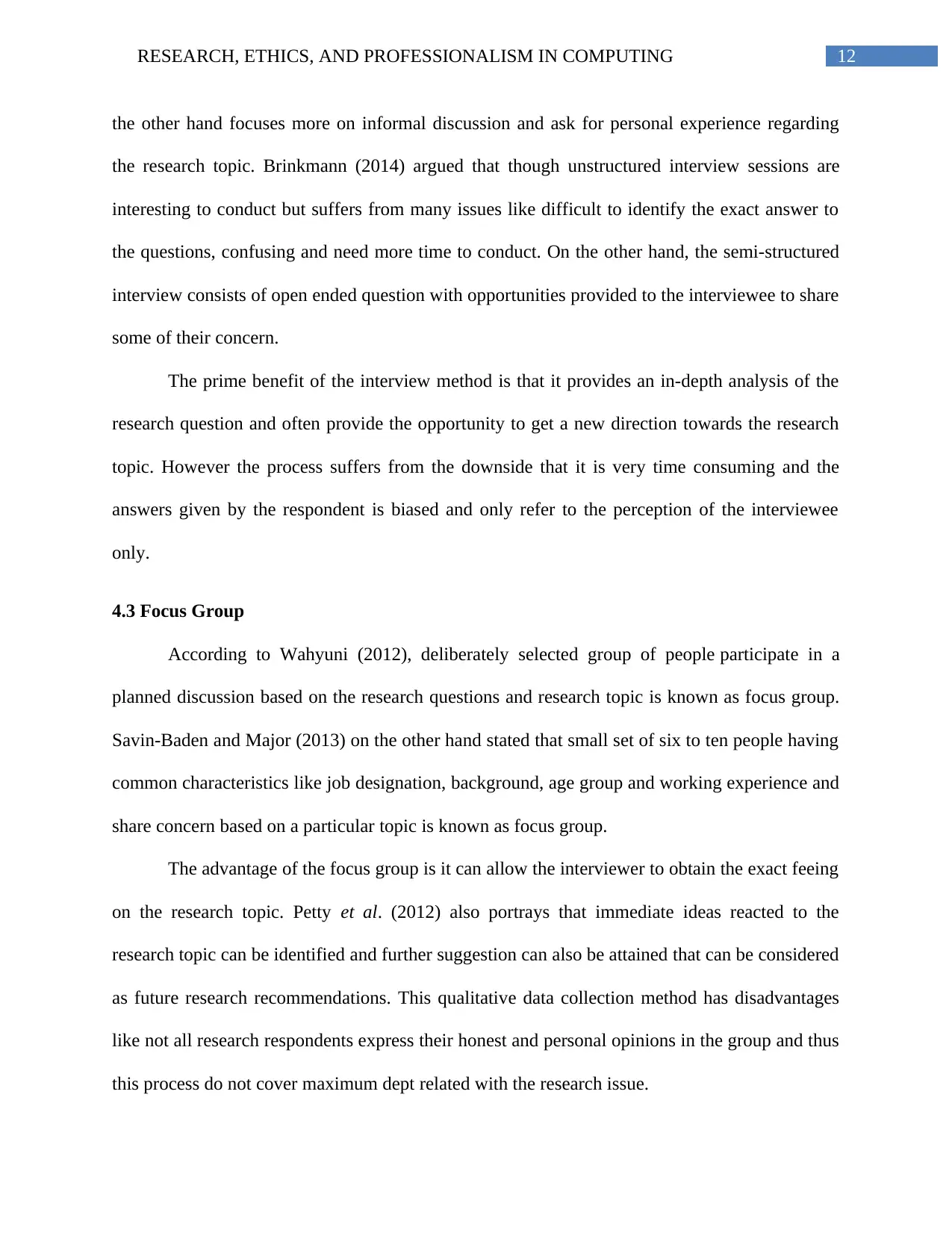
12RESEARCH, ETHICS, AND PROFESSIONALISM IN COMPUTING
the other hand focuses more on informal discussion and ask for personal experience regarding
the research topic. Brinkmann (2014) argued that though unstructured interview sessions are
interesting to conduct but suffers from many issues like difficult to identify the exact answer to
the questions, confusing and need more time to conduct. On the other hand, the semi-structured
interview consists of open ended question with opportunities provided to the interviewee to share
some of their concern.
The prime benefit of the interview method is that it provides an in-depth analysis of the
research question and often provide the opportunity to get a new direction towards the research
topic. However the process suffers from the downside that it is very time consuming and the
answers given by the respondent is biased and only refer to the perception of the interviewee
only.
4.3 Focus Group
According to Wahyuni (2012), deliberately selected group of people participate in a
planned discussion based on the research questions and research topic is known as focus group.
Savin-Baden and Major (2013) on the other hand stated that small set of six to ten people having
common characteristics like job designation, background, age group and working experience and
share concern based on a particular topic is known as focus group.
The advantage of the focus group is it can allow the interviewer to obtain the exact feeing
on the research topic. Petty et al. (2012) also portrays that immediate ideas reacted to the
research topic can be identified and further suggestion can also be attained that can be considered
as future research recommendations. This qualitative data collection method has disadvantages
like not all research respondents express their honest and personal opinions in the group and thus
this process do not cover maximum dept related with the research issue.
the other hand focuses more on informal discussion and ask for personal experience regarding
the research topic. Brinkmann (2014) argued that though unstructured interview sessions are
interesting to conduct but suffers from many issues like difficult to identify the exact answer to
the questions, confusing and need more time to conduct. On the other hand, the semi-structured
interview consists of open ended question with opportunities provided to the interviewee to share
some of their concern.
The prime benefit of the interview method is that it provides an in-depth analysis of the
research question and often provide the opportunity to get a new direction towards the research
topic. However the process suffers from the downside that it is very time consuming and the
answers given by the respondent is biased and only refer to the perception of the interviewee
only.
4.3 Focus Group
According to Wahyuni (2012), deliberately selected group of people participate in a
planned discussion based on the research questions and research topic is known as focus group.
Savin-Baden and Major (2013) on the other hand stated that small set of six to ten people having
common characteristics like job designation, background, age group and working experience and
share concern based on a particular topic is known as focus group.
The advantage of the focus group is it can allow the interviewer to obtain the exact feeing
on the research topic. Petty et al. (2012) also portrays that immediate ideas reacted to the
research topic can be identified and further suggestion can also be attained that can be considered
as future research recommendations. This qualitative data collection method has disadvantages
like not all research respondents express their honest and personal opinions in the group and thus
this process do not cover maximum dept related with the research issue.
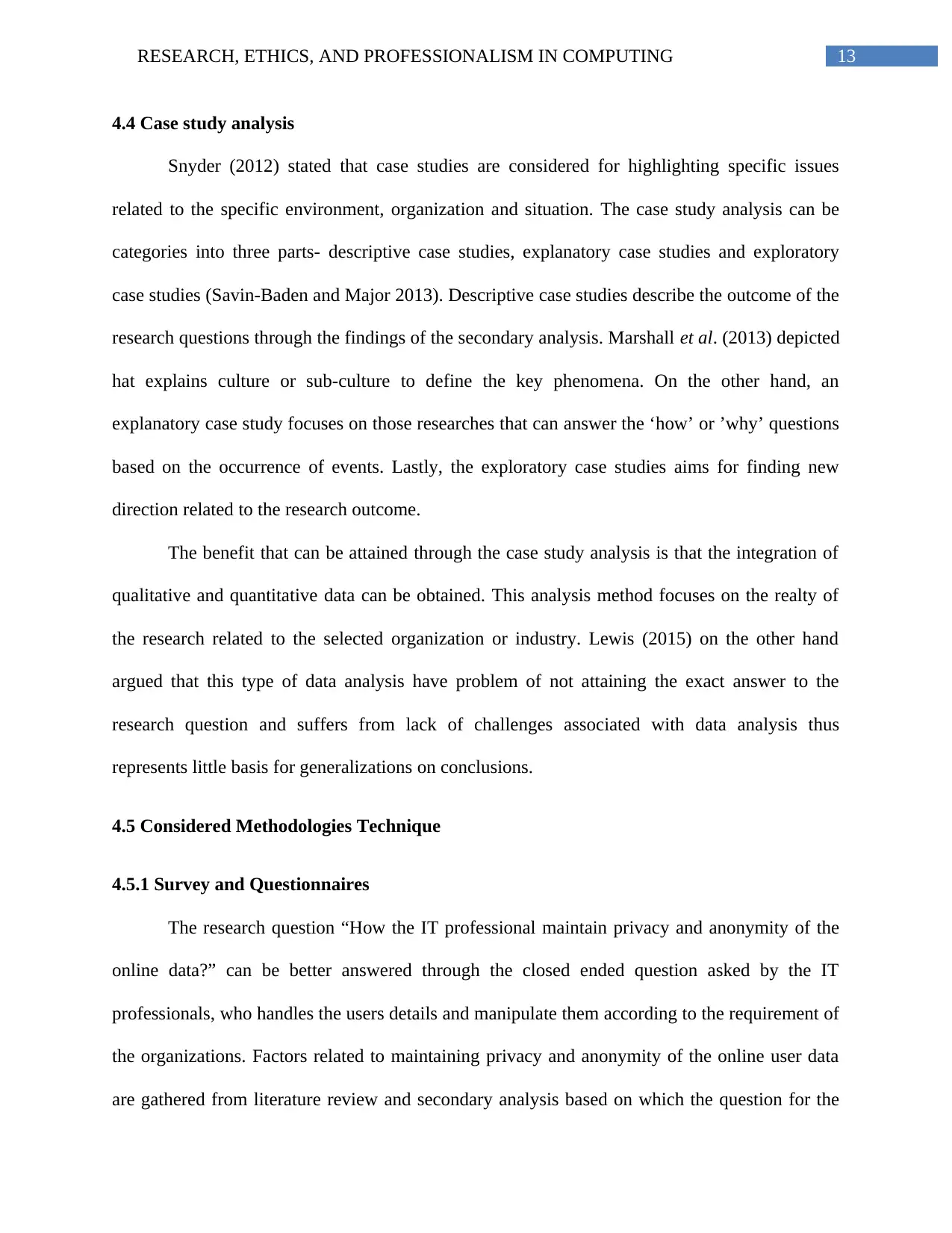
13RESEARCH, ETHICS, AND PROFESSIONALISM IN COMPUTING
4.4 Case study analysis
Snyder (2012) stated that case studies are considered for highlighting specific issues
related to the specific environment, organization and situation. The case study analysis can be
categories into three parts- descriptive case studies, explanatory case studies and exploratory
case studies (Savin-Baden and Major 2013). Descriptive case studies describe the outcome of the
research questions through the findings of the secondary analysis. Marshall et al. (2013) depicted
hat explains culture or sub-culture to define the key phenomena. On the other hand, an
explanatory case study focuses on those researches that can answer the ‘how’ or ’why’ questions
based on the occurrence of events. Lastly, the exploratory case studies aims for finding new
direction related to the research outcome.
The benefit that can be attained through the case study analysis is that the integration of
qualitative and quantitative data can be obtained. This analysis method focuses on the realty of
the research related to the selected organization or industry. Lewis (2015) on the other hand
argued that this type of data analysis have problem of not attaining the exact answer to the
research question and suffers from lack of challenges associated with data analysis thus
represents little basis for generalizations on conclusions.
4.5 Considered Methodologies Technique
4.5.1 Survey and Questionnaires
The research question “How the IT professional maintain privacy and anonymity of the
online data?” can be better answered through the closed ended question asked by the IT
professionals, who handles the users details and manipulate them according to the requirement of
the organizations. Factors related to maintaining privacy and anonymity of the online user data
are gathered from literature review and secondary analysis based on which the question for the
4.4 Case study analysis
Snyder (2012) stated that case studies are considered for highlighting specific issues
related to the specific environment, organization and situation. The case study analysis can be
categories into three parts- descriptive case studies, explanatory case studies and exploratory
case studies (Savin-Baden and Major 2013). Descriptive case studies describe the outcome of the
research questions through the findings of the secondary analysis. Marshall et al. (2013) depicted
hat explains culture or sub-culture to define the key phenomena. On the other hand, an
explanatory case study focuses on those researches that can answer the ‘how’ or ’why’ questions
based on the occurrence of events. Lastly, the exploratory case studies aims for finding new
direction related to the research outcome.
The benefit that can be attained through the case study analysis is that the integration of
qualitative and quantitative data can be obtained. This analysis method focuses on the realty of
the research related to the selected organization or industry. Lewis (2015) on the other hand
argued that this type of data analysis have problem of not attaining the exact answer to the
research question and suffers from lack of challenges associated with data analysis thus
represents little basis for generalizations on conclusions.
4.5 Considered Methodologies Technique
4.5.1 Survey and Questionnaires
The research question “How the IT professional maintain privacy and anonymity of the
online data?” can be better answered through the closed ended question asked by the IT
professionals, who handles the users details and manipulate them according to the requirement of
the organizations. Factors related to maintaining privacy and anonymity of the online user data
are gathered from literature review and secondary analysis based on which the question for the
Paraphrase This Document
Need a fresh take? Get an instant paraphrase of this document with our AI Paraphraser
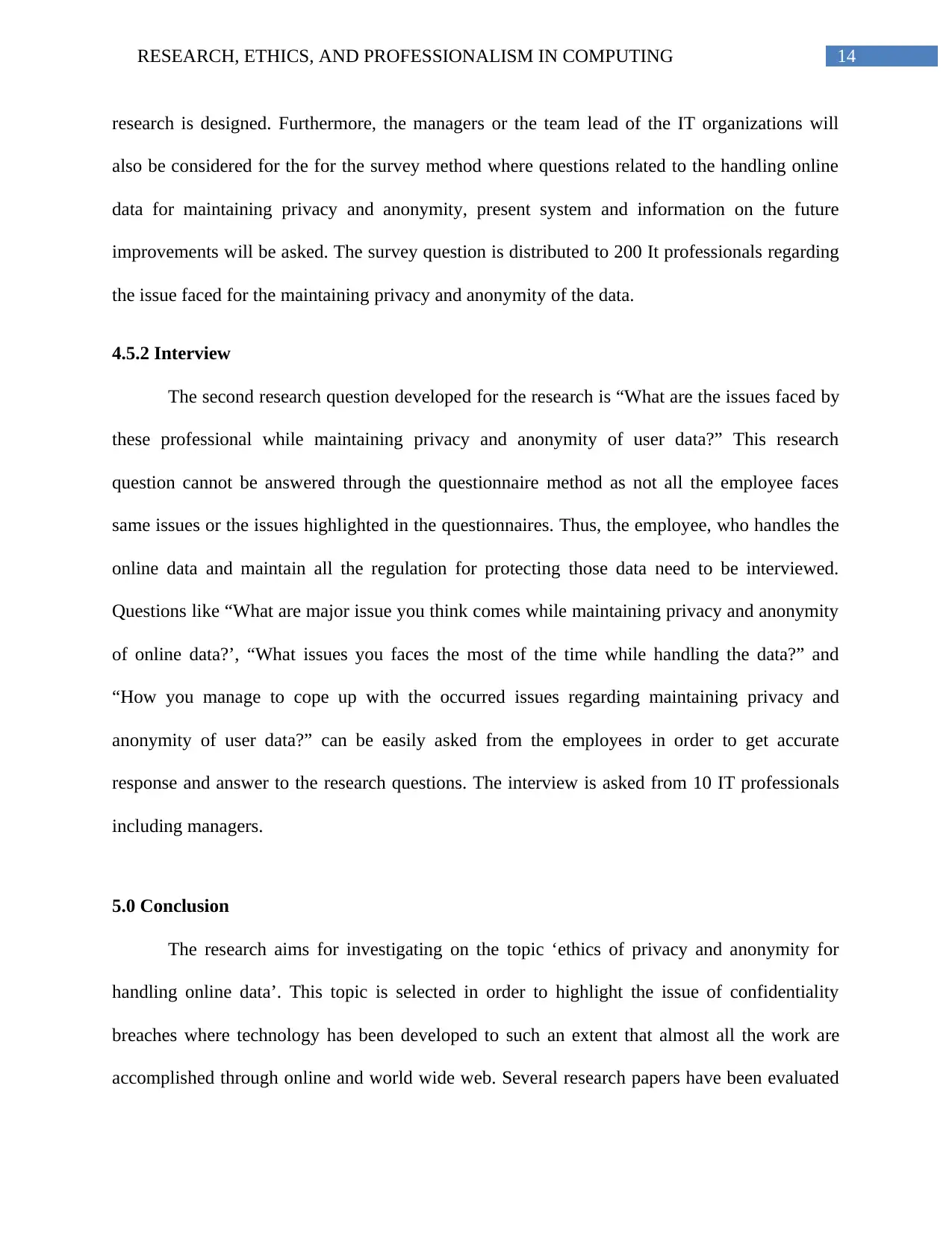
14RESEARCH, ETHICS, AND PROFESSIONALISM IN COMPUTING
research is designed. Furthermore, the managers or the team lead of the IT organizations will
also be considered for the for the survey method where questions related to the handling online
data for maintaining privacy and anonymity, present system and information on the future
improvements will be asked. The survey question is distributed to 200 It professionals regarding
the issue faced for the maintaining privacy and anonymity of the data.
4.5.2 Interview
The second research question developed for the research is “What are the issues faced by
these professional while maintaining privacy and anonymity of user data?” This research
question cannot be answered through the questionnaire method as not all the employee faces
same issues or the issues highlighted in the questionnaires. Thus, the employee, who handles the
online data and maintain all the regulation for protecting those data need to be interviewed.
Questions like “What are major issue you think comes while maintaining privacy and anonymity
of online data?’, “What issues you faces the most of the time while handling the data?” and
“How you manage to cope up with the occurred issues regarding maintaining privacy and
anonymity of user data?” can be easily asked from the employees in order to get accurate
response and answer to the research questions. The interview is asked from 10 IT professionals
including managers.
5.0 Conclusion
The research aims for investigating on the topic ‘ethics of privacy and anonymity for
handling online data’. This topic is selected in order to highlight the issue of confidentiality
breaches where technology has been developed to such an extent that almost all the work are
accomplished through online and world wide web. Several research papers have been evaluated
research is designed. Furthermore, the managers or the team lead of the IT organizations will
also be considered for the for the survey method where questions related to the handling online
data for maintaining privacy and anonymity, present system and information on the future
improvements will be asked. The survey question is distributed to 200 It professionals regarding
the issue faced for the maintaining privacy and anonymity of the data.
4.5.2 Interview
The second research question developed for the research is “What are the issues faced by
these professional while maintaining privacy and anonymity of user data?” This research
question cannot be answered through the questionnaire method as not all the employee faces
same issues or the issues highlighted in the questionnaires. Thus, the employee, who handles the
online data and maintain all the regulation for protecting those data need to be interviewed.
Questions like “What are major issue you think comes while maintaining privacy and anonymity
of online data?’, “What issues you faces the most of the time while handling the data?” and
“How you manage to cope up with the occurred issues regarding maintaining privacy and
anonymity of user data?” can be easily asked from the employees in order to get accurate
response and answer to the research questions. The interview is asked from 10 IT professionals
including managers.
5.0 Conclusion
The research aims for investigating on the topic ‘ethics of privacy and anonymity for
handling online data’. This topic is selected in order to highlight the issue of confidentiality
breaches where technology has been developed to such an extent that almost all the work are
accomplished through online and world wide web. Several research papers have been evaluated
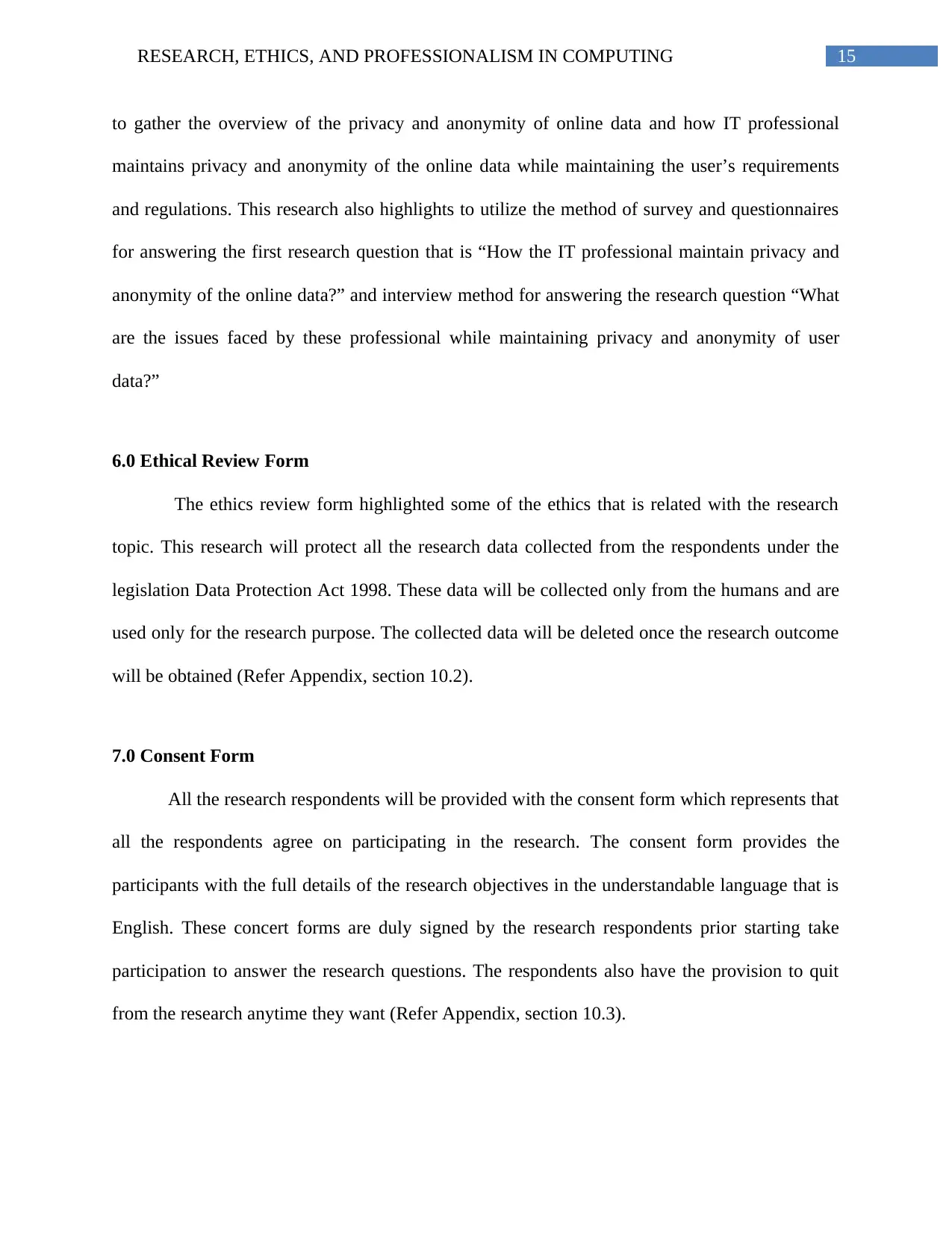
15RESEARCH, ETHICS, AND PROFESSIONALISM IN COMPUTING
to gather the overview of the privacy and anonymity of online data and how IT professional
maintains privacy and anonymity of the online data while maintaining the user’s requirements
and regulations. This research also highlights to utilize the method of survey and questionnaires
for answering the first research question that is “How the IT professional maintain privacy and
anonymity of the online data?” and interview method for answering the research question “What
are the issues faced by these professional while maintaining privacy and anonymity of user
data?”
6.0 Ethical Review Form
The ethics review form highlighted some of the ethics that is related with the research
topic. This research will protect all the research data collected from the respondents under the
legislation Data Protection Act 1998. These data will be collected only from the humans and are
used only for the research purpose. The collected data will be deleted once the research outcome
will be obtained (Refer Appendix, section 10.2).
7.0 Consent Form
All the research respondents will be provided with the consent form which represents that
all the respondents agree on participating in the research. The consent form provides the
participants with the full details of the research objectives in the understandable language that is
English. These concert forms are duly signed by the research respondents prior starting take
participation to answer the research questions. The respondents also have the provision to quit
from the research anytime they want (Refer Appendix, section 10.3).
to gather the overview of the privacy and anonymity of online data and how IT professional
maintains privacy and anonymity of the online data while maintaining the user’s requirements
and regulations. This research also highlights to utilize the method of survey and questionnaires
for answering the first research question that is “How the IT professional maintain privacy and
anonymity of the online data?” and interview method for answering the research question “What
are the issues faced by these professional while maintaining privacy and anonymity of user
data?”
6.0 Ethical Review Form
The ethics review form highlighted some of the ethics that is related with the research
topic. This research will protect all the research data collected from the respondents under the
legislation Data Protection Act 1998. These data will be collected only from the humans and are
used only for the research purpose. The collected data will be deleted once the research outcome
will be obtained (Refer Appendix, section 10.2).
7.0 Consent Form
All the research respondents will be provided with the consent form which represents that
all the respondents agree on participating in the research. The consent form provides the
participants with the full details of the research objectives in the understandable language that is
English. These concert forms are duly signed by the research respondents prior starting take
participation to answer the research questions. The respondents also have the provision to quit
from the research anytime they want (Refer Appendix, section 10.3).
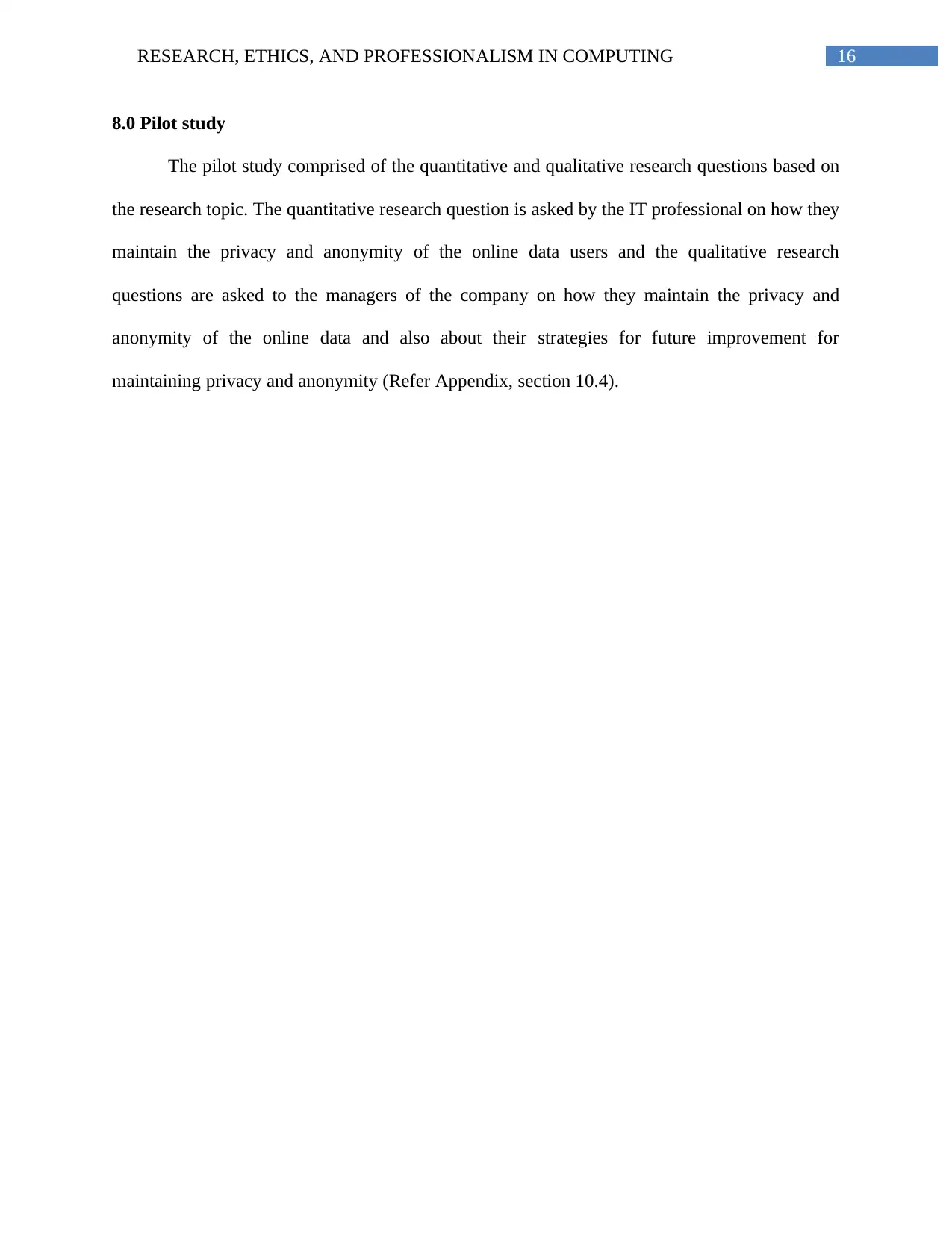
16RESEARCH, ETHICS, AND PROFESSIONALISM IN COMPUTING
8.0 Pilot study
The pilot study comprised of the quantitative and qualitative research questions based on
the research topic. The quantitative research question is asked by the IT professional on how they
maintain the privacy and anonymity of the online data users and the qualitative research
questions are asked to the managers of the company on how they maintain the privacy and
anonymity of the online data and also about their strategies for future improvement for
maintaining privacy and anonymity (Refer Appendix, section 10.4).
8.0 Pilot study
The pilot study comprised of the quantitative and qualitative research questions based on
the research topic. The quantitative research question is asked by the IT professional on how they
maintain the privacy and anonymity of the online data users and the qualitative research
questions are asked to the managers of the company on how they maintain the privacy and
anonymity of the online data and also about their strategies for future improvement for
maintaining privacy and anonymity (Refer Appendix, section 10.4).
Secure Best Marks with AI Grader
Need help grading? Try our AI Grader for instant feedback on your assignments.
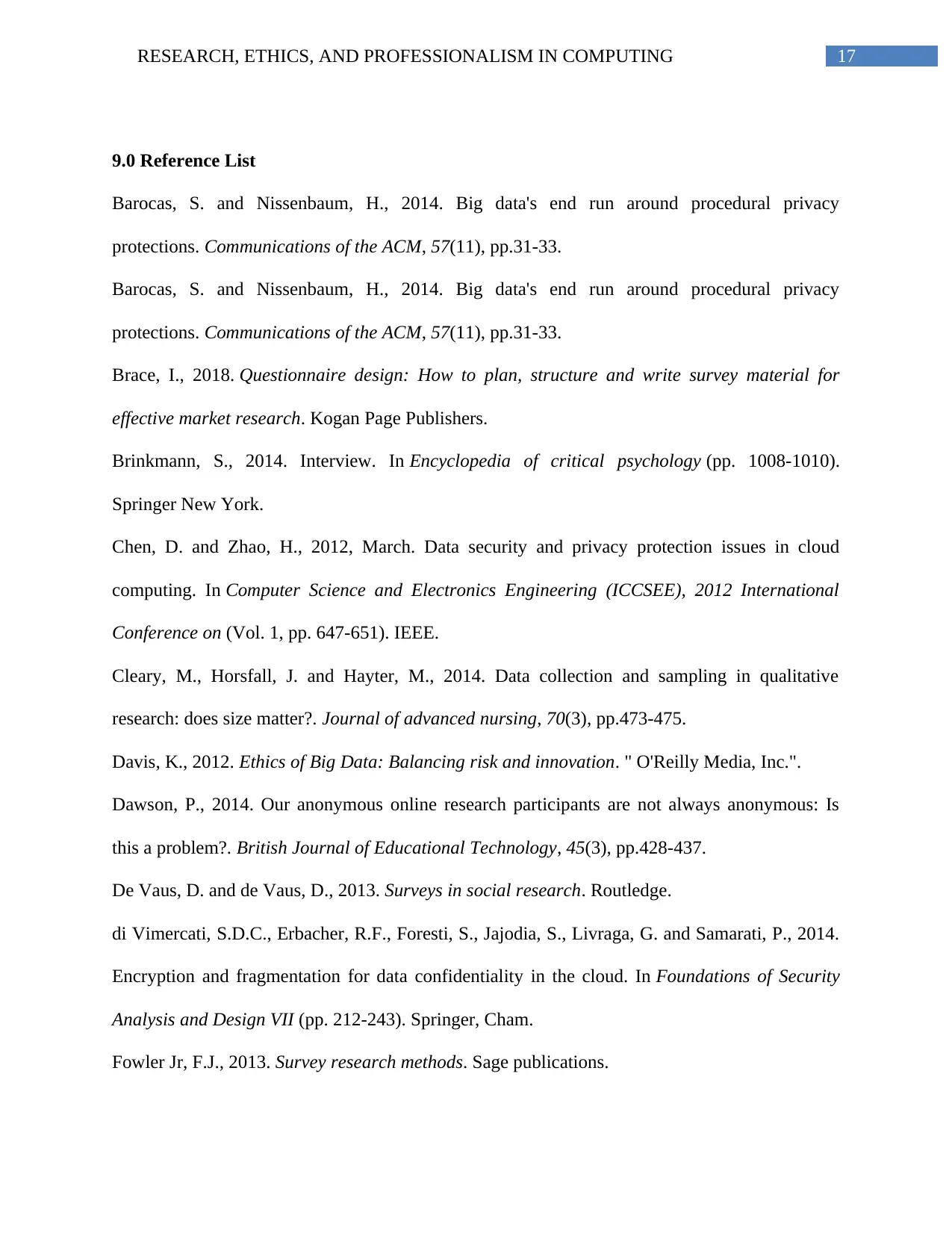
17RESEARCH, ETHICS, AND PROFESSIONALISM IN COMPUTING
9.0 Reference List
Barocas, S. and Nissenbaum, H., 2014. Big data's end run around procedural privacy
protections. Communications of the ACM, 57(11), pp.31-33.
Barocas, S. and Nissenbaum, H., 2014. Big data's end run around procedural privacy
protections. Communications of the ACM, 57(11), pp.31-33.
Brace, I., 2018. Questionnaire design: How to plan, structure and write survey material for
effective market research. Kogan Page Publishers.
Brinkmann, S., 2014. Interview. In Encyclopedia of critical psychology (pp. 1008-1010).
Springer New York.
Chen, D. and Zhao, H., 2012, March. Data security and privacy protection issues in cloud
computing. In Computer Science and Electronics Engineering (ICCSEE), 2012 International
Conference on (Vol. 1, pp. 647-651). IEEE.
Cleary, M., Horsfall, J. and Hayter, M., 2014. Data collection and sampling in qualitative
research: does size matter?. Journal of advanced nursing, 70(3), pp.473-475.
Davis, K., 2012. Ethics of Big Data: Balancing risk and innovation. " O'Reilly Media, Inc.".
Dawson, P., 2014. Our anonymous online research participants are not always anonymous: Is
this a problem?. British Journal of Educational Technology, 45(3), pp.428-437.
De Vaus, D. and de Vaus, D., 2013. Surveys in social research. Routledge.
di Vimercati, S.D.C., Erbacher, R.F., Foresti, S., Jajodia, S., Livraga, G. and Samarati, P., 2014.
Encryption and fragmentation for data confidentiality in the cloud. In Foundations of Security
Analysis and Design VII (pp. 212-243). Springer, Cham.
Fowler Jr, F.J., 2013. Survey research methods. Sage publications.
9.0 Reference List
Barocas, S. and Nissenbaum, H., 2014. Big data's end run around procedural privacy
protections. Communications of the ACM, 57(11), pp.31-33.
Barocas, S. and Nissenbaum, H., 2014. Big data's end run around procedural privacy
protections. Communications of the ACM, 57(11), pp.31-33.
Brace, I., 2018. Questionnaire design: How to plan, structure and write survey material for
effective market research. Kogan Page Publishers.
Brinkmann, S., 2014. Interview. In Encyclopedia of critical psychology (pp. 1008-1010).
Springer New York.
Chen, D. and Zhao, H., 2012, March. Data security and privacy protection issues in cloud
computing. In Computer Science and Electronics Engineering (ICCSEE), 2012 International
Conference on (Vol. 1, pp. 647-651). IEEE.
Cleary, M., Horsfall, J. and Hayter, M., 2014. Data collection and sampling in qualitative
research: does size matter?. Journal of advanced nursing, 70(3), pp.473-475.
Davis, K., 2012. Ethics of Big Data: Balancing risk and innovation. " O'Reilly Media, Inc.".
Dawson, P., 2014. Our anonymous online research participants are not always anonymous: Is
this a problem?. British Journal of Educational Technology, 45(3), pp.428-437.
De Vaus, D. and de Vaus, D., 2013. Surveys in social research. Routledge.
di Vimercati, S.D.C., Erbacher, R.F., Foresti, S., Jajodia, S., Livraga, G. and Samarati, P., 2014.
Encryption and fragmentation for data confidentiality in the cloud. In Foundations of Security
Analysis and Design VII (pp. 212-243). Springer, Cham.
Fowler Jr, F.J., 2013. Survey research methods. Sage publications.
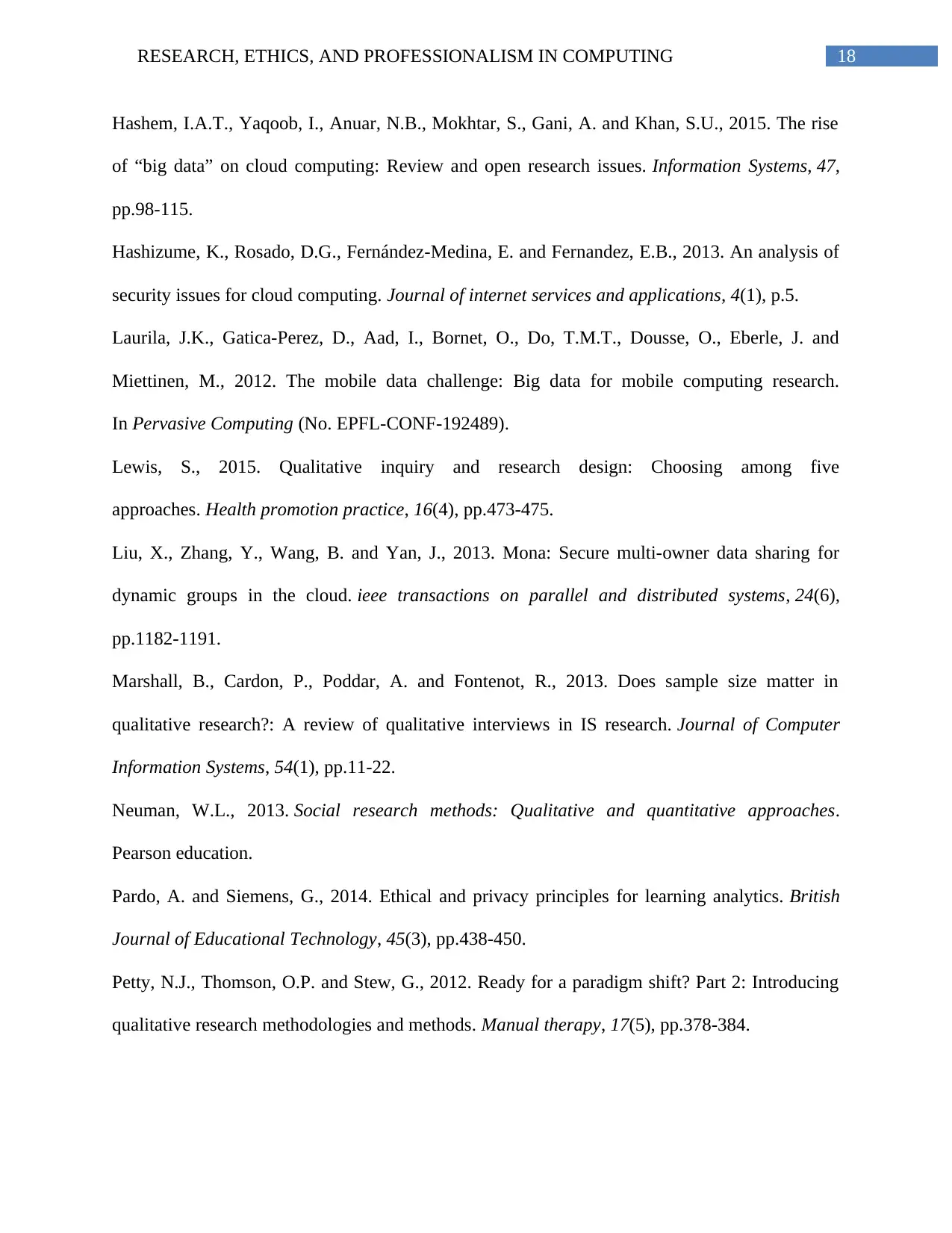
18RESEARCH, ETHICS, AND PROFESSIONALISM IN COMPUTING
Hashem, I.A.T., Yaqoob, I., Anuar, N.B., Mokhtar, S., Gani, A. and Khan, S.U., 2015. The rise
of “big data” on cloud computing: Review and open research issues. Information Systems, 47,
pp.98-115.
Hashizume, K., Rosado, D.G., Fernández-Medina, E. and Fernandez, E.B., 2013. An analysis of
security issues for cloud computing. Journal of internet services and applications, 4(1), p.5.
Laurila, J.K., Gatica-Perez, D., Aad, I., Bornet, O., Do, T.M.T., Dousse, O., Eberle, J. and
Miettinen, M., 2012. The mobile data challenge: Big data for mobile computing research.
In Pervasive Computing (No. EPFL-CONF-192489).
Lewis, S., 2015. Qualitative inquiry and research design: Choosing among five
approaches. Health promotion practice, 16(4), pp.473-475.
Liu, X., Zhang, Y., Wang, B. and Yan, J., 2013. Mona: Secure multi-owner data sharing for
dynamic groups in the cloud. ieee transactions on parallel and distributed systems, 24(6),
pp.1182-1191.
Marshall, B., Cardon, P., Poddar, A. and Fontenot, R., 2013. Does sample size matter in
qualitative research?: A review of qualitative interviews in IS research. Journal of Computer
Information Systems, 54(1), pp.11-22.
Neuman, W.L., 2013. Social research methods: Qualitative and quantitative approaches.
Pearson education.
Pardo, A. and Siemens, G., 2014. Ethical and privacy principles for learning analytics. British
Journal of Educational Technology, 45(3), pp.438-450.
Petty, N.J., Thomson, O.P. and Stew, G., 2012. Ready for a paradigm shift? Part 2: Introducing
qualitative research methodologies and methods. Manual therapy, 17(5), pp.378-384.
Hashem, I.A.T., Yaqoob, I., Anuar, N.B., Mokhtar, S., Gani, A. and Khan, S.U., 2015. The rise
of “big data” on cloud computing: Review and open research issues. Information Systems, 47,
pp.98-115.
Hashizume, K., Rosado, D.G., Fernández-Medina, E. and Fernandez, E.B., 2013. An analysis of
security issues for cloud computing. Journal of internet services and applications, 4(1), p.5.
Laurila, J.K., Gatica-Perez, D., Aad, I., Bornet, O., Do, T.M.T., Dousse, O., Eberle, J. and
Miettinen, M., 2012. The mobile data challenge: Big data for mobile computing research.
In Pervasive Computing (No. EPFL-CONF-192489).
Lewis, S., 2015. Qualitative inquiry and research design: Choosing among five
approaches. Health promotion practice, 16(4), pp.473-475.
Liu, X., Zhang, Y., Wang, B. and Yan, J., 2013. Mona: Secure multi-owner data sharing for
dynamic groups in the cloud. ieee transactions on parallel and distributed systems, 24(6),
pp.1182-1191.
Marshall, B., Cardon, P., Poddar, A. and Fontenot, R., 2013. Does sample size matter in
qualitative research?: A review of qualitative interviews in IS research. Journal of Computer
Information Systems, 54(1), pp.11-22.
Neuman, W.L., 2013. Social research methods: Qualitative and quantitative approaches.
Pearson education.
Pardo, A. and Siemens, G., 2014. Ethical and privacy principles for learning analytics. British
Journal of Educational Technology, 45(3), pp.438-450.
Petty, N.J., Thomson, O.P. and Stew, G., 2012. Ready for a paradigm shift? Part 2: Introducing
qualitative research methodologies and methods. Manual therapy, 17(5), pp.378-384.
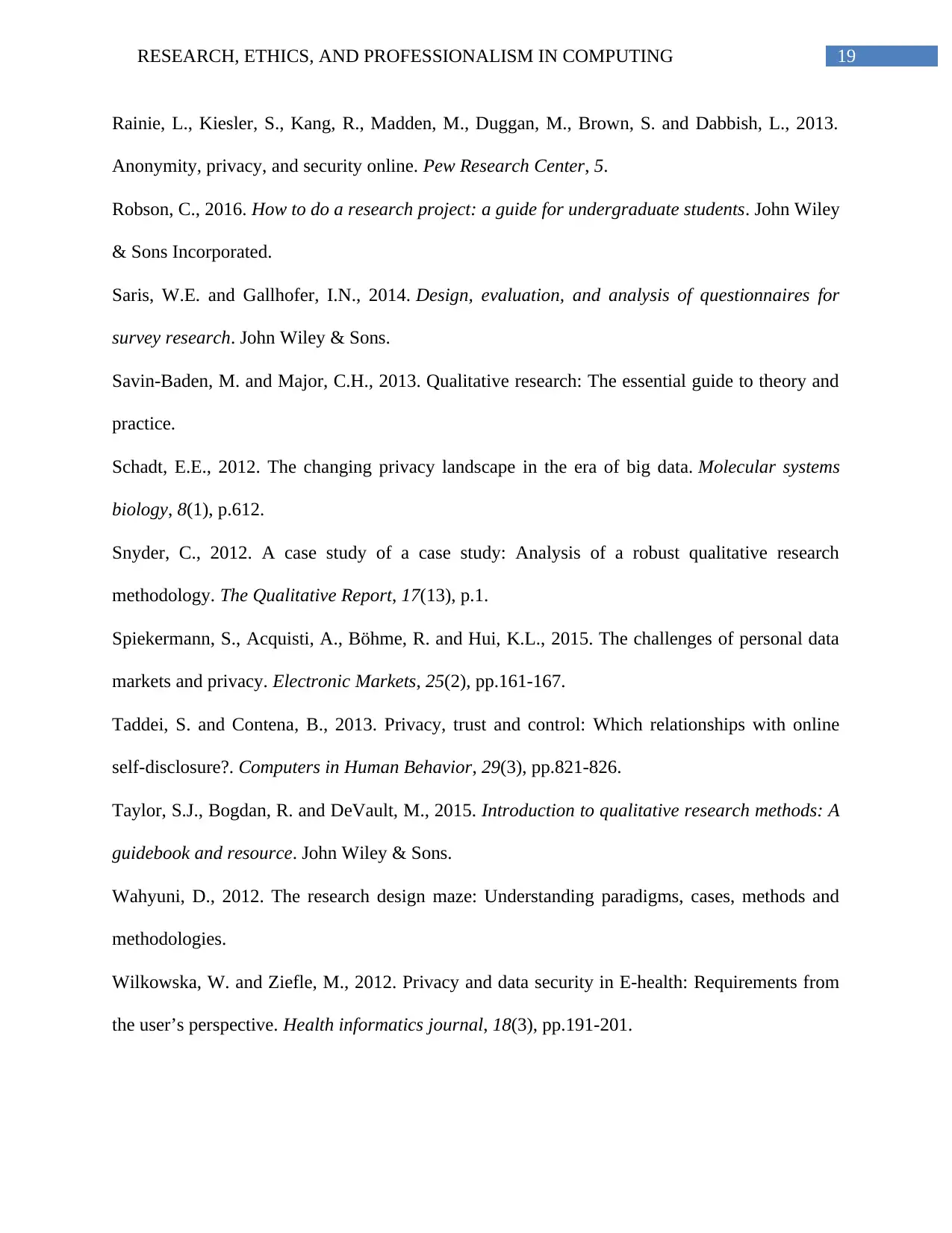
19RESEARCH, ETHICS, AND PROFESSIONALISM IN COMPUTING
Rainie, L., Kiesler, S., Kang, R., Madden, M., Duggan, M., Brown, S. and Dabbish, L., 2013.
Anonymity, privacy, and security online. Pew Research Center, 5.
Robson, C., 2016. How to do a research project: a guide for undergraduate students. John Wiley
& Sons Incorporated.
Saris, W.E. and Gallhofer, I.N., 2014. Design, evaluation, and analysis of questionnaires for
survey research. John Wiley & Sons.
Savin-Baden, M. and Major, C.H., 2013. Qualitative research: The essential guide to theory and
practice.
Schadt, E.E., 2012. The changing privacy landscape in the era of big data. Molecular systems
biology, 8(1), p.612.
Snyder, C., 2012. A case study of a case study: Analysis of a robust qualitative research
methodology. The Qualitative Report, 17(13), p.1.
Spiekermann, S., Acquisti, A., Böhme, R. and Hui, K.L., 2015. The challenges of personal data
markets and privacy. Electronic Markets, 25(2), pp.161-167.
Taddei, S. and Contena, B., 2013. Privacy, trust and control: Which relationships with online
self-disclosure?. Computers in Human Behavior, 29(3), pp.821-826.
Taylor, S.J., Bogdan, R. and DeVault, M., 2015. Introduction to qualitative research methods: A
guidebook and resource. John Wiley & Sons.
Wahyuni, D., 2012. The research design maze: Understanding paradigms, cases, methods and
methodologies.
Wilkowska, W. and Ziefle, M., 2012. Privacy and data security in E-health: Requirements from
the user’s perspective. Health informatics journal, 18(3), pp.191-201.
Rainie, L., Kiesler, S., Kang, R., Madden, M., Duggan, M., Brown, S. and Dabbish, L., 2013.
Anonymity, privacy, and security online. Pew Research Center, 5.
Robson, C., 2016. How to do a research project: a guide for undergraduate students. John Wiley
& Sons Incorporated.
Saris, W.E. and Gallhofer, I.N., 2014. Design, evaluation, and analysis of questionnaires for
survey research. John Wiley & Sons.
Savin-Baden, M. and Major, C.H., 2013. Qualitative research: The essential guide to theory and
practice.
Schadt, E.E., 2012. The changing privacy landscape in the era of big data. Molecular systems
biology, 8(1), p.612.
Snyder, C., 2012. A case study of a case study: Analysis of a robust qualitative research
methodology. The Qualitative Report, 17(13), p.1.
Spiekermann, S., Acquisti, A., Böhme, R. and Hui, K.L., 2015. The challenges of personal data
markets and privacy. Electronic Markets, 25(2), pp.161-167.
Taddei, S. and Contena, B., 2013. Privacy, trust and control: Which relationships with online
self-disclosure?. Computers in Human Behavior, 29(3), pp.821-826.
Taylor, S.J., Bogdan, R. and DeVault, M., 2015. Introduction to qualitative research methods: A
guidebook and resource. John Wiley & Sons.
Wahyuni, D., 2012. The research design maze: Understanding paradigms, cases, methods and
methodologies.
Wilkowska, W. and Ziefle, M., 2012. Privacy and data security in E-health: Requirements from
the user’s perspective. Health informatics journal, 18(3), pp.191-201.
Paraphrase This Document
Need a fresh take? Get an instant paraphrase of this document with our AI Paraphraser
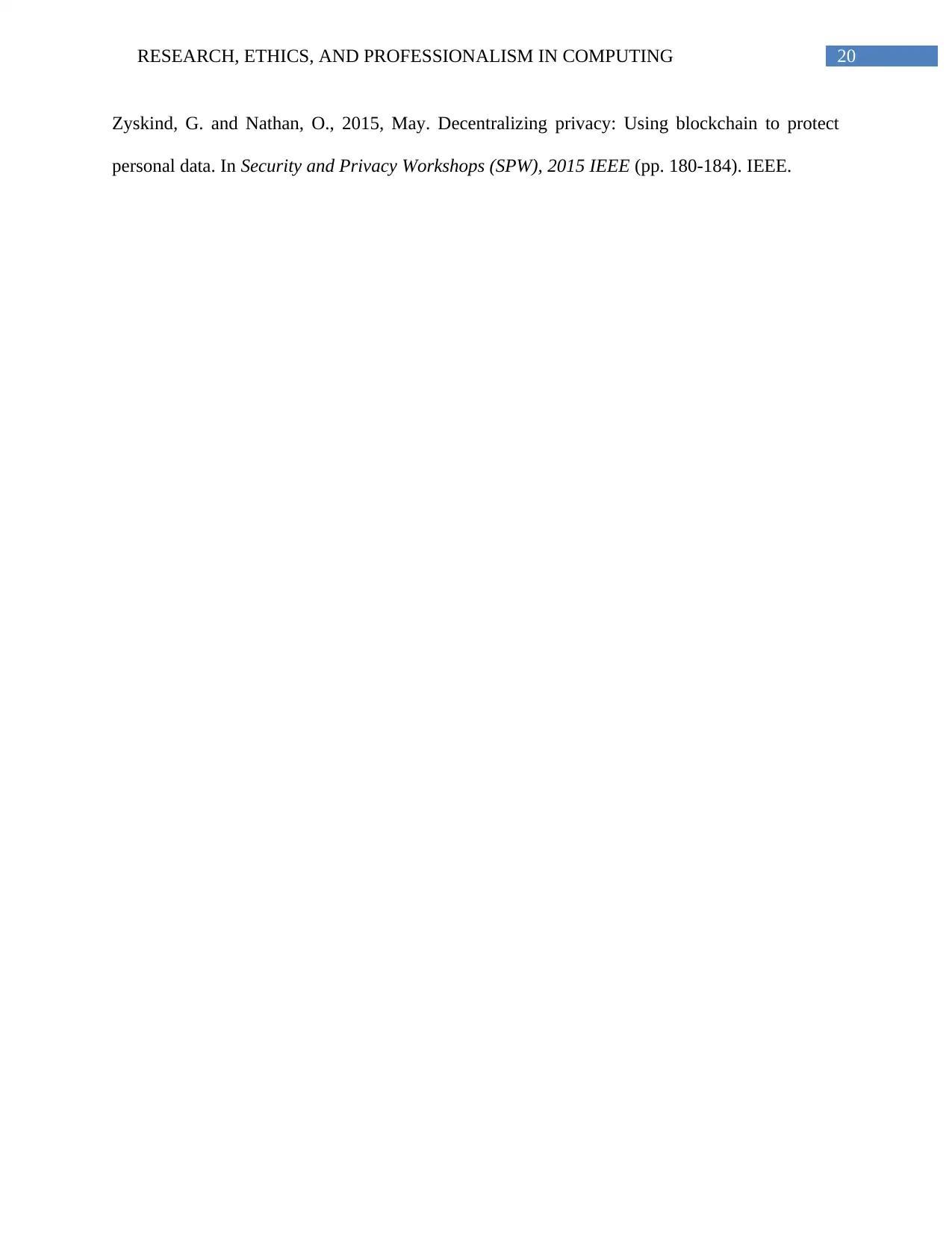
20RESEARCH, ETHICS, AND PROFESSIONALISM IN COMPUTING
Zyskind, G. and Nathan, O., 2015, May. Decentralizing privacy: Using blockchain to protect
personal data. In Security and Privacy Workshops (SPW), 2015 IEEE (pp. 180-184). IEEE.
Zyskind, G. and Nathan, O., 2015, May. Decentralizing privacy: Using blockchain to protect
personal data. In Security and Privacy Workshops (SPW), 2015 IEEE (pp. 180-184). IEEE.
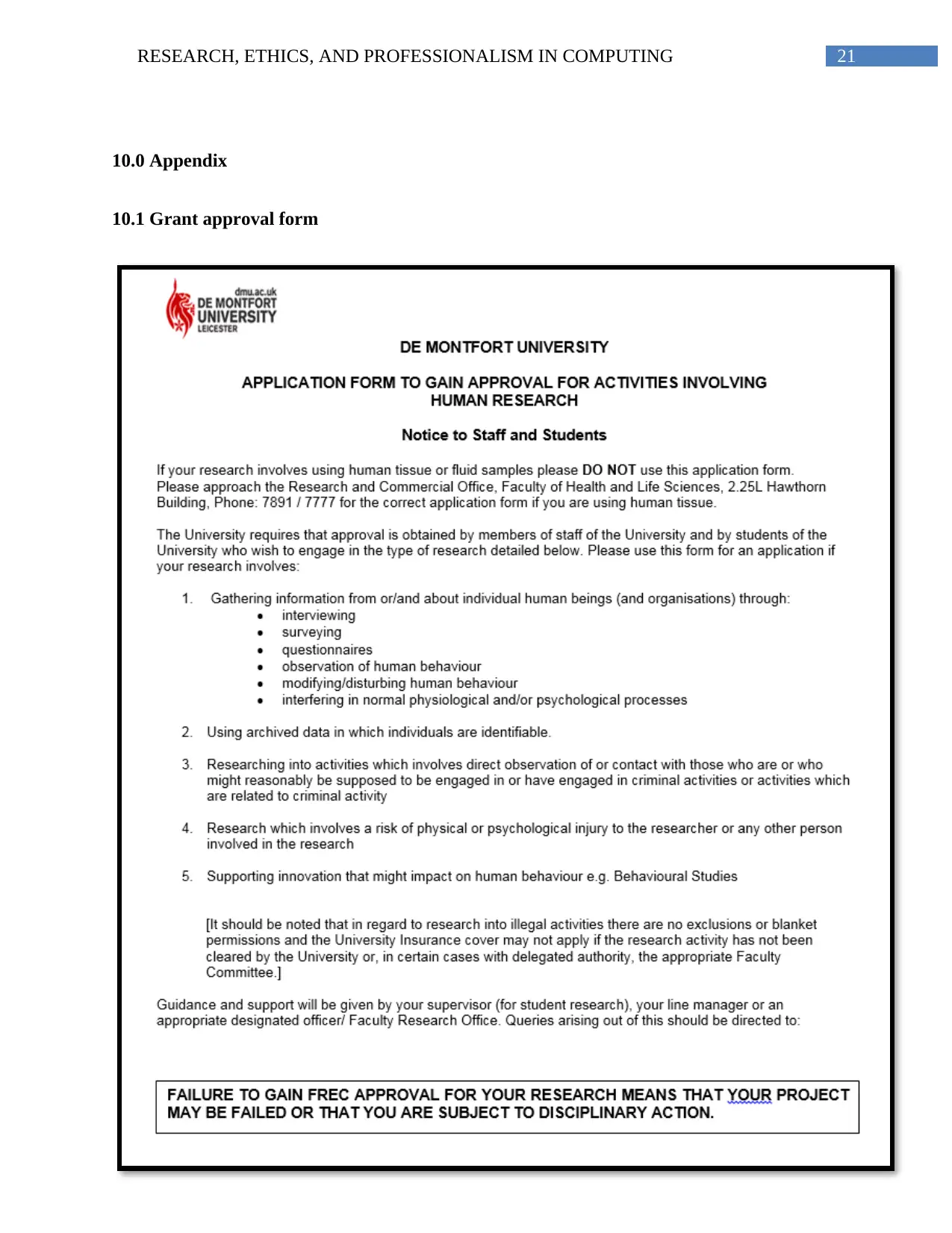
21RESEARCH, ETHICS, AND PROFESSIONALISM IN COMPUTING
10.0 Appendix
10.1 Grant approval form
10.0 Appendix
10.1 Grant approval form
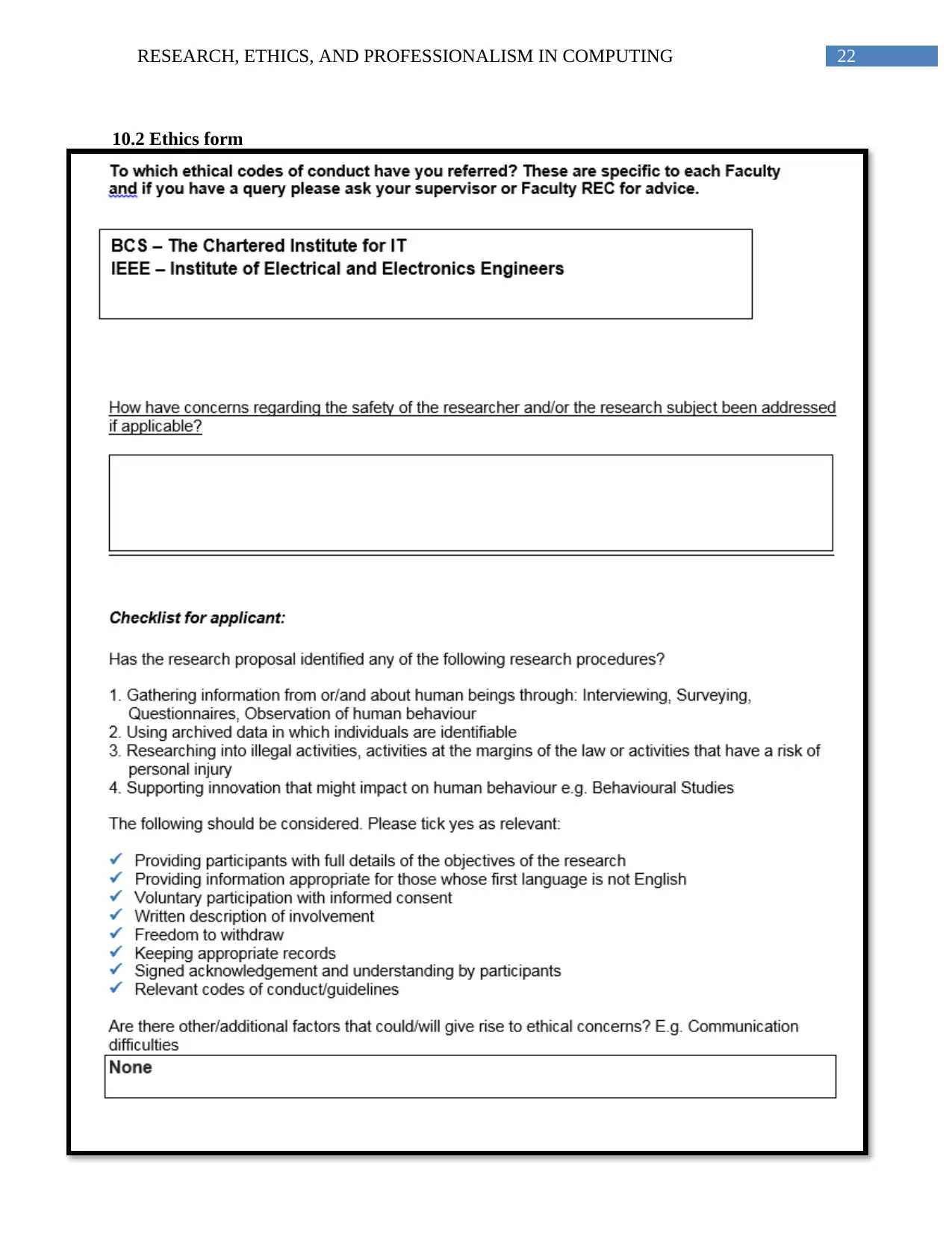
22RESEARCH, ETHICS, AND PROFESSIONALISM IN COMPUTING
10.2 Ethics form
10.2 Ethics form
Secure Best Marks with AI Grader
Need help grading? Try our AI Grader for instant feedback on your assignments.
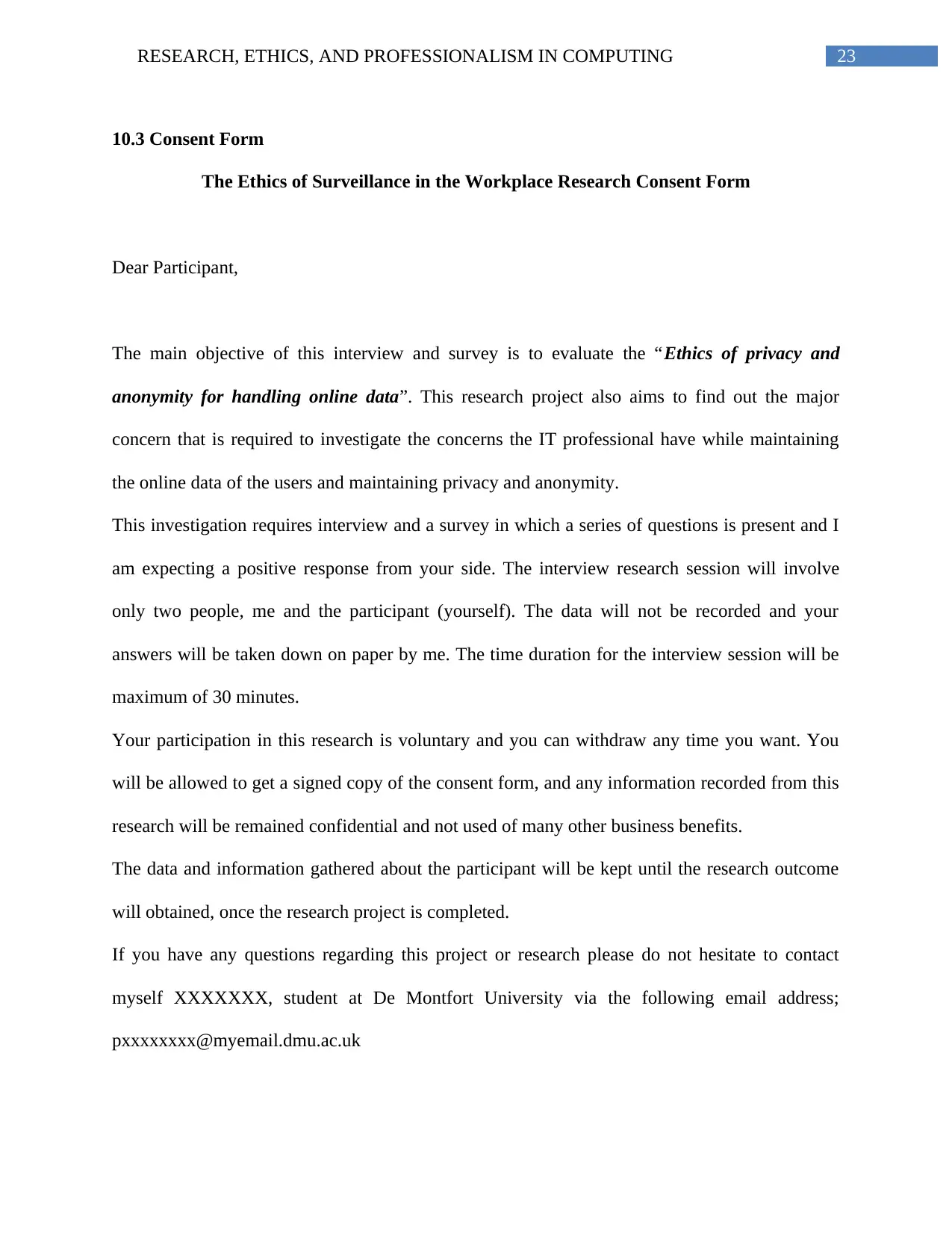
23RESEARCH, ETHICS, AND PROFESSIONALISM IN COMPUTING
10.3 Consent Form
The Ethics of Surveillance in the Workplace Research Consent Form
Dear Participant,
The main objective of this interview and survey is to evaluate the “Ethics of privacy and
anonymity for handling online data”. This research project also aims to find out the major
concern that is required to investigate the concerns the IT professional have while maintaining
the online data of the users and maintaining privacy and anonymity.
This investigation requires interview and a survey in which a series of questions is present and I
am expecting a positive response from your side. The interview research session will involve
only two people, me and the participant (yourself). The data will not be recorded and your
answers will be taken down on paper by me. The time duration for the interview session will be
maximum of 30 minutes.
Your participation in this research is voluntary and you can withdraw any time you want. You
will be allowed to get a signed copy of the consent form, and any information recorded from this
research will be remained confidential and not used of many other business benefits.
The data and information gathered about the participant will be kept until the research outcome
will obtained, once the research project is completed.
If you have any questions regarding this project or research please do not hesitate to contact
myself XXXXXXX, student at De Montfort University via the following email address;
pxxxxxxxx@myemail.dmu.ac.uk
10.3 Consent Form
The Ethics of Surveillance in the Workplace Research Consent Form
Dear Participant,
The main objective of this interview and survey is to evaluate the “Ethics of privacy and
anonymity for handling online data”. This research project also aims to find out the major
concern that is required to investigate the concerns the IT professional have while maintaining
the online data of the users and maintaining privacy and anonymity.
This investigation requires interview and a survey in which a series of questions is present and I
am expecting a positive response from your side. The interview research session will involve
only two people, me and the participant (yourself). The data will not be recorded and your
answers will be taken down on paper by me. The time duration for the interview session will be
maximum of 30 minutes.
Your participation in this research is voluntary and you can withdraw any time you want. You
will be allowed to get a signed copy of the consent form, and any information recorded from this
research will be remained confidential and not used of many other business benefits.
The data and information gathered about the participant will be kept until the research outcome
will obtained, once the research project is completed.
If you have any questions regarding this project or research please do not hesitate to contact
myself XXXXXXX, student at De Montfort University via the following email address;
pxxxxxxxx@myemail.dmu.ac.uk
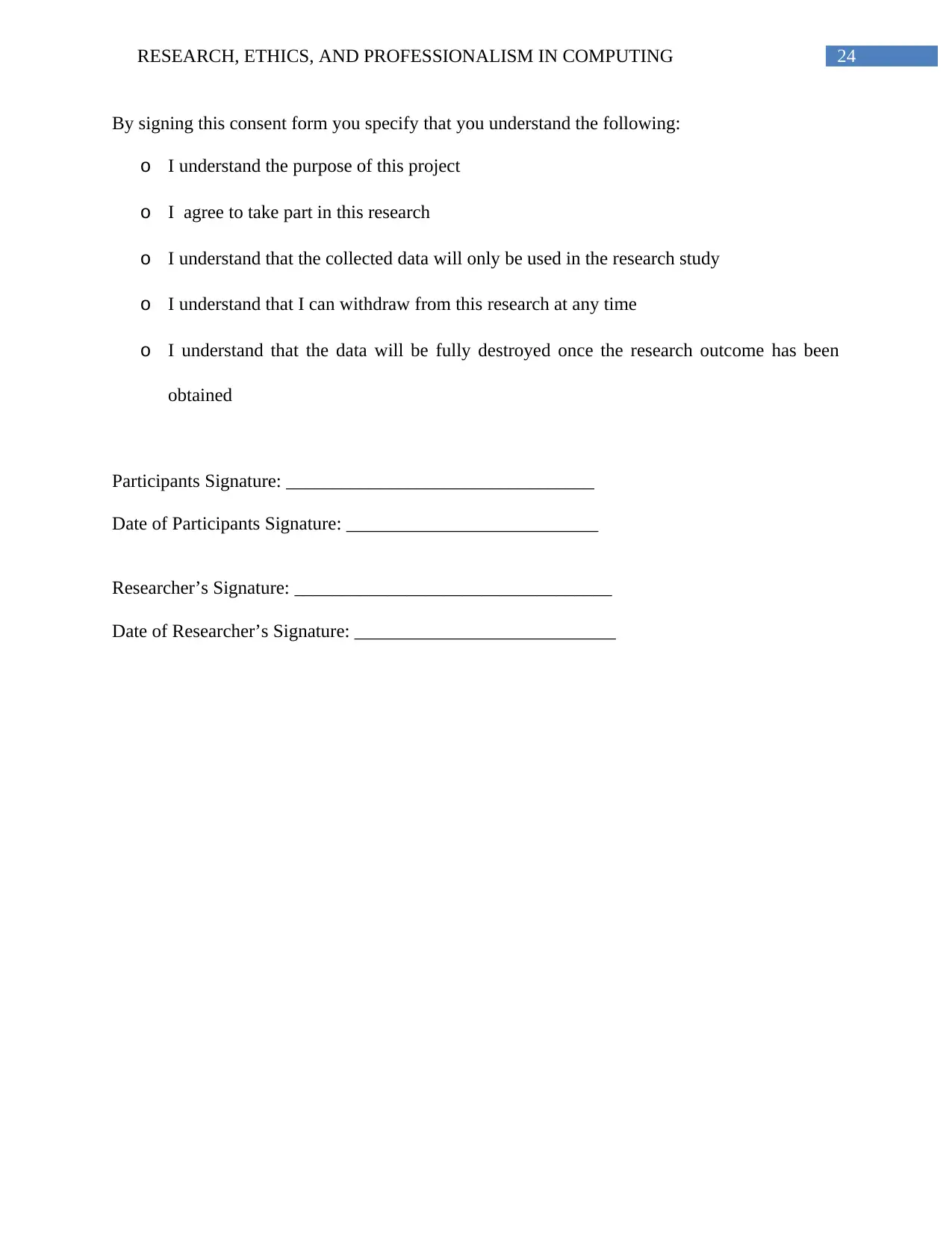
24RESEARCH, ETHICS, AND PROFESSIONALISM IN COMPUTING
By signing this consent form you specify that you understand the following:
o I understand the purpose of this project
o I agree to take part in this research
o I understand that the collected data will only be used in the research study
o I understand that I can withdraw from this research at any time
o I understand that the data will be fully destroyed once the research outcome has been
obtained
Participants Signature: _________________________________
Date of Participants Signature: ___________________________
Researcher’s Signature: __________________________________
Date of Researcher’s Signature: ____________________________
By signing this consent form you specify that you understand the following:
o I understand the purpose of this project
o I agree to take part in this research
o I understand that the collected data will only be used in the research study
o I understand that I can withdraw from this research at any time
o I understand that the data will be fully destroyed once the research outcome has been
obtained
Participants Signature: _________________________________
Date of Participants Signature: ___________________________
Researcher’s Signature: __________________________________
Date of Researcher’s Signature: ____________________________
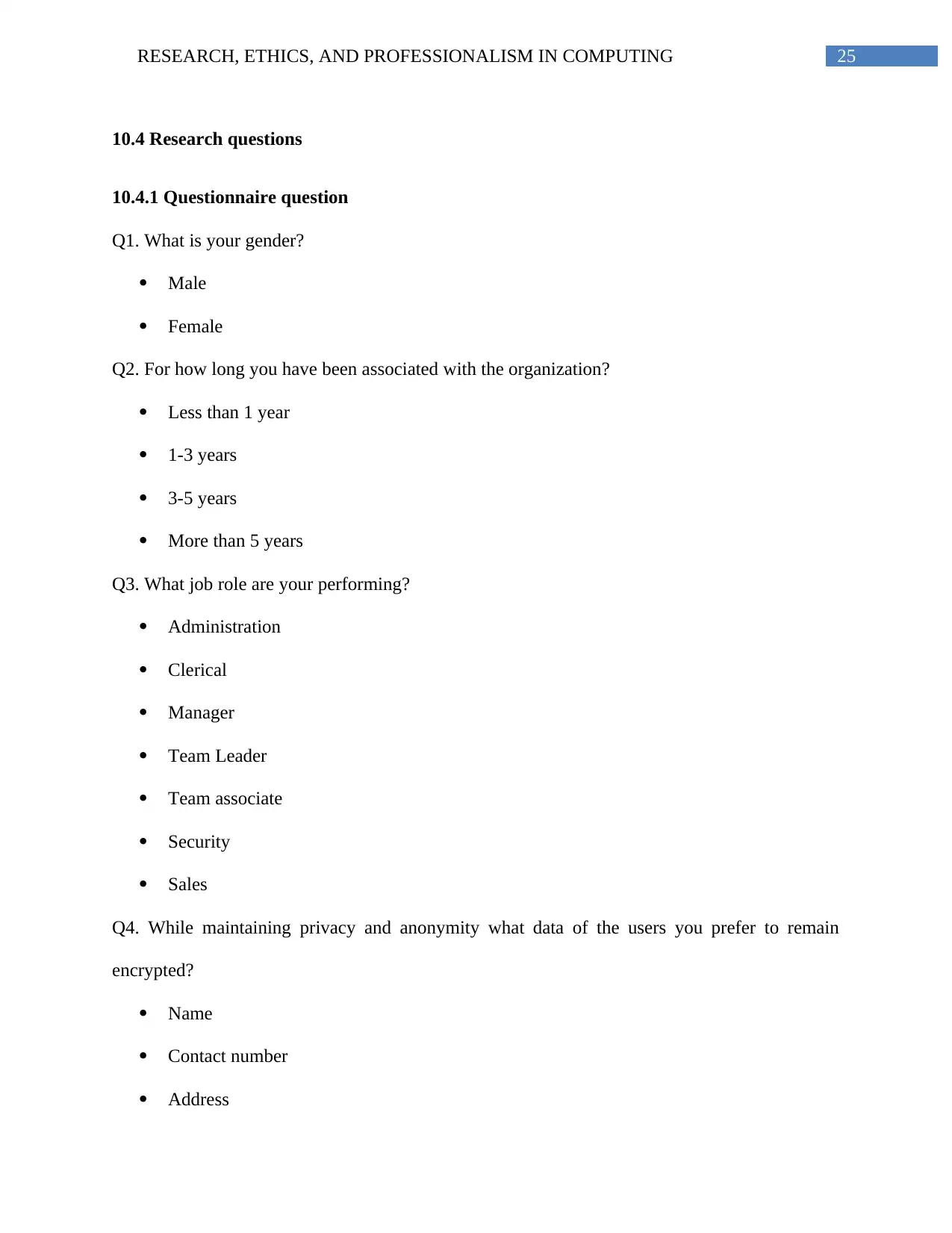
25RESEARCH, ETHICS, AND PROFESSIONALISM IN COMPUTING
10.4 Research questions
10.4.1 Questionnaire question
Q1. What is your gender?
Male
Female
Q2. For how long you have been associated with the organization?
Less than 1 year
1-3 years
3-5 years
More than 5 years
Q3. What job role are your performing?
Administration
Clerical
Manager
Team Leader
Team associate
Security
Sales
Q4. While maintaining privacy and anonymity what data of the users you prefer to remain
encrypted?
Name
Contact number
Address
10.4 Research questions
10.4.1 Questionnaire question
Q1. What is your gender?
Male
Female
Q2. For how long you have been associated with the organization?
Less than 1 year
1-3 years
3-5 years
More than 5 years
Q3. What job role are your performing?
Administration
Clerical
Manager
Team Leader
Team associate
Security
Sales
Q4. While maintaining privacy and anonymity what data of the users you prefer to remain
encrypted?
Name
Contact number
Address
Paraphrase This Document
Need a fresh take? Get an instant paraphrase of this document with our AI Paraphraser
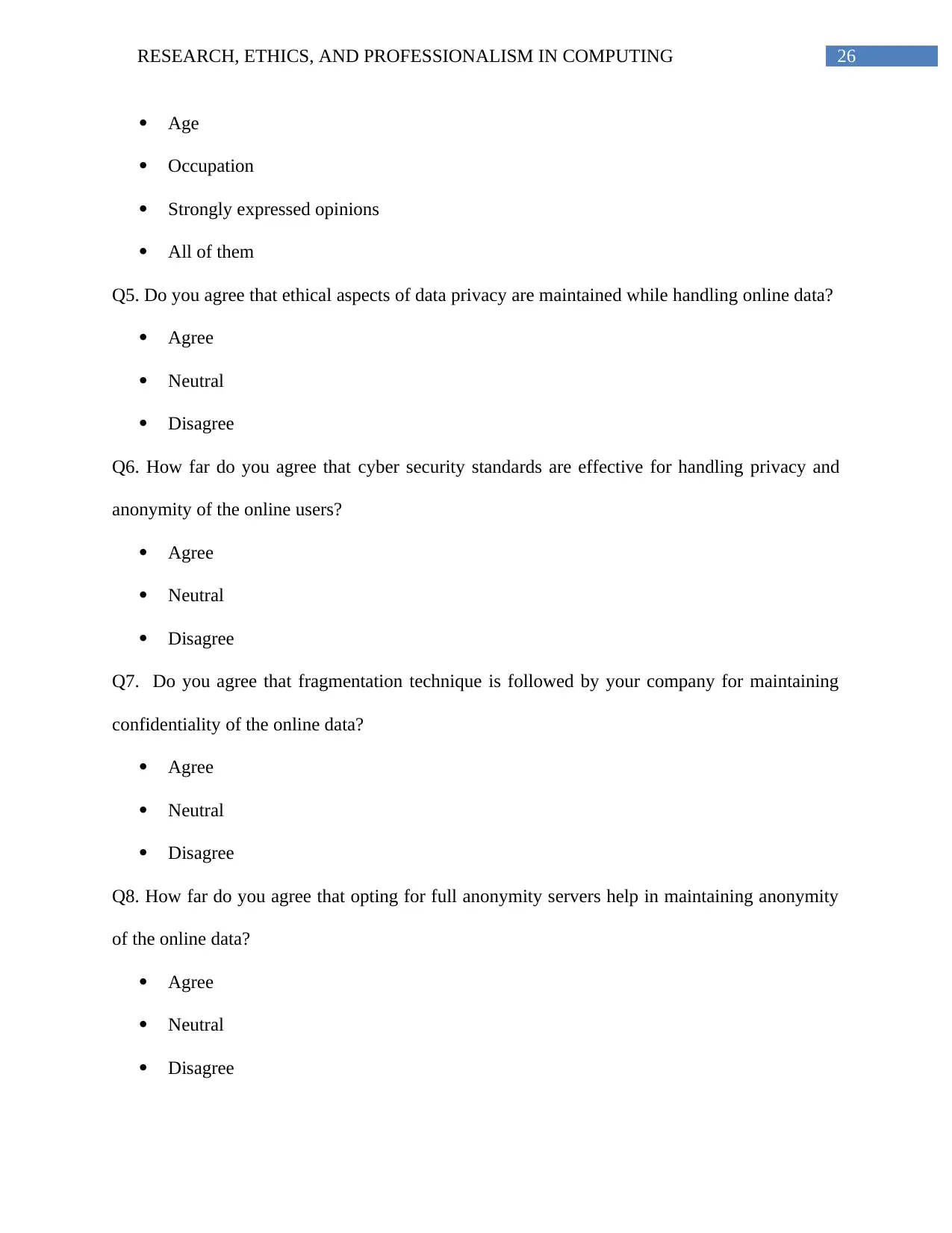
26RESEARCH, ETHICS, AND PROFESSIONALISM IN COMPUTING
Age
Occupation
Strongly expressed opinions
All of them
Q5. Do you agree that ethical aspects of data privacy are maintained while handling online data?
Agree
Neutral
Disagree
Q6. How far do you agree that cyber security standards are effective for handling privacy and
anonymity of the online users?
Agree
Neutral
Disagree
Q7. Do you agree that fragmentation technique is followed by your company for maintaining
confidentiality of the online data?
Agree
Neutral
Disagree
Q8. How far do you agree that opting for full anonymity servers help in maintaining anonymity
of the online data?
Agree
Neutral
Disagree
Age
Occupation
Strongly expressed opinions
All of them
Q5. Do you agree that ethical aspects of data privacy are maintained while handling online data?
Agree
Neutral
Disagree
Q6. How far do you agree that cyber security standards are effective for handling privacy and
anonymity of the online users?
Agree
Neutral
Disagree
Q7. Do you agree that fragmentation technique is followed by your company for maintaining
confidentiality of the online data?
Agree
Neutral
Disagree
Q8. How far do you agree that opting for full anonymity servers help in maintaining anonymity
of the online data?
Agree
Neutral
Disagree
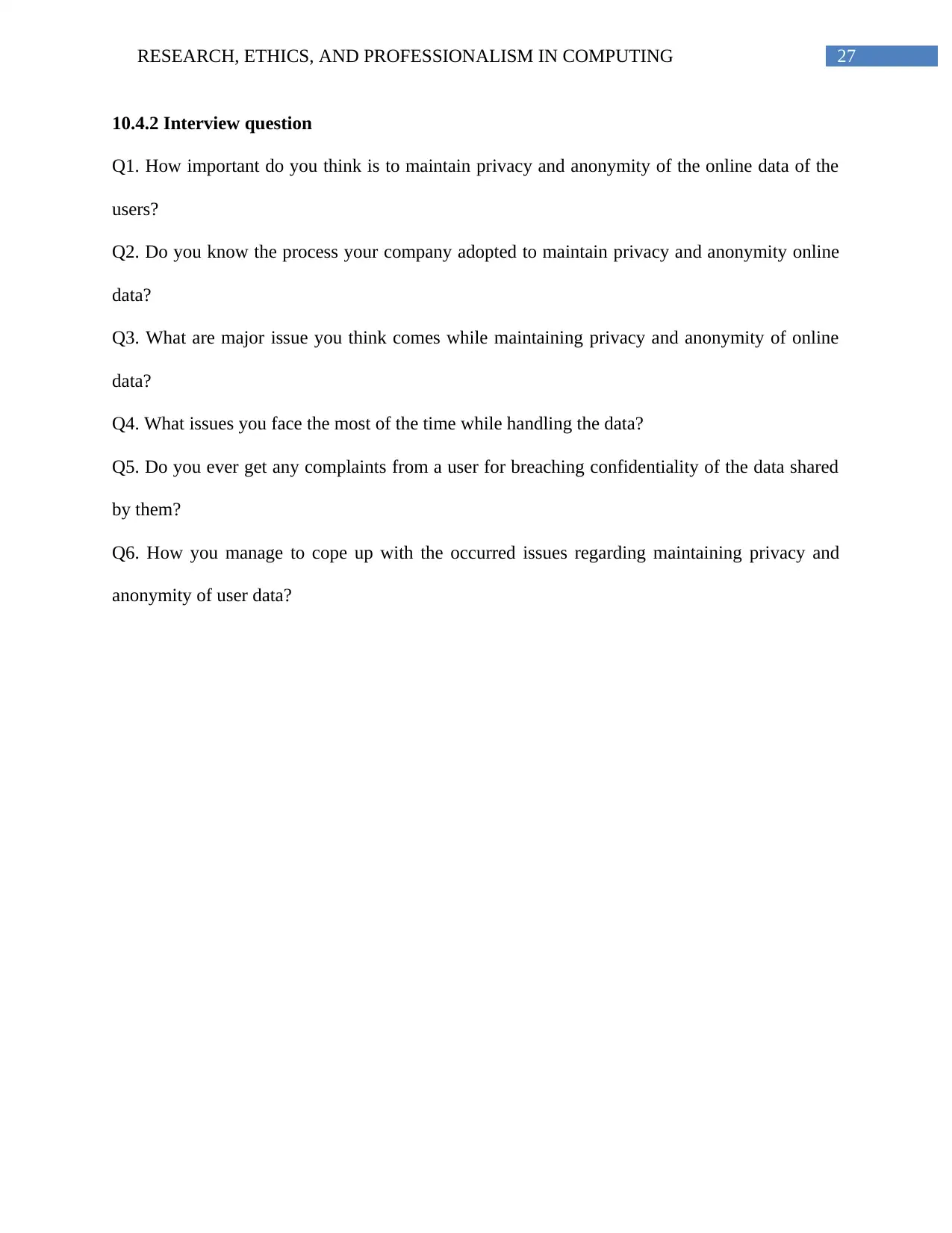
27RESEARCH, ETHICS, AND PROFESSIONALISM IN COMPUTING
10.4.2 Interview question
Q1. How important do you think is to maintain privacy and anonymity of the online data of the
users?
Q2. Do you know the process your company adopted to maintain privacy and anonymity online
data?
Q3. What are major issue you think comes while maintaining privacy and anonymity of online
data?
Q4. What issues you face the most of the time while handling the data?
Q5. Do you ever get any complaints from a user for breaching confidentiality of the data shared
by them?
Q6. How you manage to cope up with the occurred issues regarding maintaining privacy and
anonymity of user data?
10.4.2 Interview question
Q1. How important do you think is to maintain privacy and anonymity of the online data of the
users?
Q2. Do you know the process your company adopted to maintain privacy and anonymity online
data?
Q3. What are major issue you think comes while maintaining privacy and anonymity of online
data?
Q4. What issues you face the most of the time while handling the data?
Q5. Do you ever get any complaints from a user for breaching confidentiality of the data shared
by them?
Q6. How you manage to cope up with the occurred issues regarding maintaining privacy and
anonymity of user data?
1 out of 27
Related Documents
Your All-in-One AI-Powered Toolkit for Academic Success.
+13062052269
info@desklib.com
Available 24*7 on WhatsApp / Email
![[object Object]](/_next/static/media/star-bottom.7253800d.svg)
Unlock your academic potential
© 2024 | Zucol Services PVT LTD | All rights reserved.





